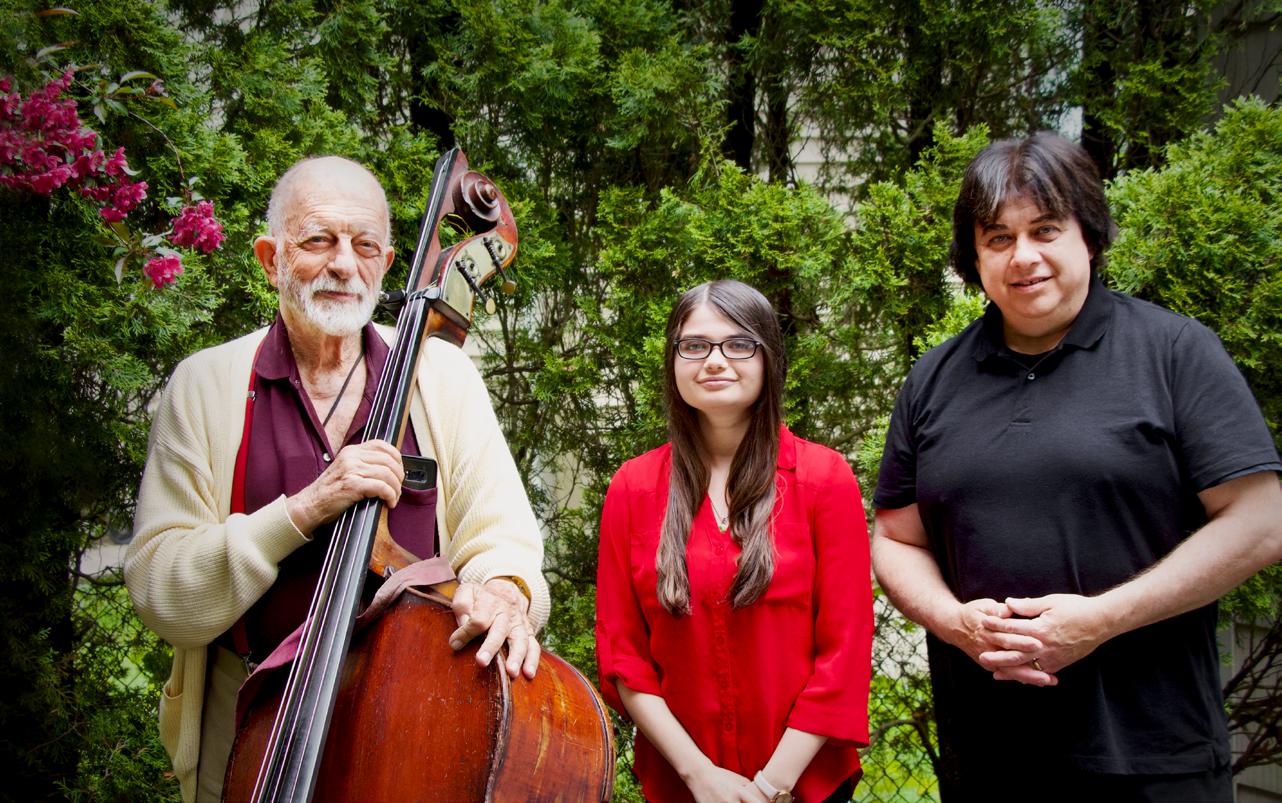
THE MAGAZINE OF THE NEW JERSEY JAZZ SOCIETY JUNE 2021 VOLUME 49 ISSUE 06
JerseyJazz 3 GENERATIONS OF JAZZ
Bill Crow, Leonieke Scheuble, and Nick Scheuble
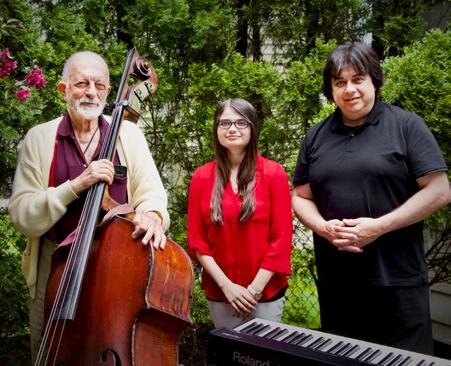
In “Carnegie Hall Youth Ensemble Will Have a New Jersey Cadence This Summer” (JJ May 2021), composer/arranger/bandleader Jihye Lee composed a piece for the 2020 NYO Jazz Orchestra, not this year’s. Also, one of the NYO Jazz faculty members is trumpeter Erica von Kleist; her name was misstated.
In “Remembering Andy Fusco” by Walt Weiskopf, the last sentence in column 3, should have read: “A real artist is never satisfied for long with an accomplishment.
02 JUNE 2021 JERSEY JAZZ NJJS.ORG
08 Jazz History: Erroll Garner 13 Three Generations of Jazz 18 Melissa Aldana 22 Talking Jazz: Ed Cherry 29 Rising Star: Lucy Wijnands 36 Remembering Curtis Fuller, Norman Simmons and Bob Koester 42 Book Review: Sax Appeal 44 Other Views COLUMNS 03 All That’s Jazz 05 Editor’s Choice 33 From the Crow’s Nest 48 Jazzwords 49 Not Without You ON THE COVER Leonieke Scheuble & the Generations of Jazz Trio PHOTO BY CYDNEY HALPIN.
IN THIS ISSUE ARTICLES/REVIEWS
CORRECTIONS
ALL THAT’S JAZZ
BY CYDNEY HALPIN

Jersey Jazz magazine is a wonderful benefit of NJJS membership and, after several months of transition with our new website, it has been password protected with FULL accesses available once again to NJJS MEMBERS only.
At the beginning of each month, you’ll receive an eBlast containing the new password and the link to the current month’s issue. You’ll be prompted to input the password after you click on the “View Digital Issue” tab. Once you’ve accessed the magazine, you’ll be able to download it to your computer or other personal device for ease of access throughout the month. If you prefer not to download the issue, keep the monthly password handy so you can continue to access the issue online. If you have any questions, please contact me at pres@njjs.org.
Please Note: NJJS’s primary way
of communicating with our members is via email. Make certain you have New Jersey Jazz Society’s email addresses eblast@njjs.org and membership@njjs.org —in your Contacts File and that you mark correspondence from NJJS as “not spam.”
It’s with great pride and privilege that the Board of Directors and
I announce that Dan Morgenstern — longstanding Jersey Jazz contributor—has been bestowed two Lifetime Achievement Awards, one from the Association for Recorded Sound Collections in recognition of his life’s work in recorded sound research and publication, and the other from the Louis Armstrong Educational Foundation.
For those who may not know Dan, he’s one of the jazz world’s greatest living treasures!
The following is excerpted from
the Louis Armstrong International Continuum 2021 Virtual Symposium and Concert program:
Born October 24, 1929, in Germany, Morgenstern was reared in Austria and Denmark, before his move to the United States in 1947. His passion for jazz was born in Copenhagen. Shortly after his arrival in New York City, he gravitated to 52nd street, known as “Swing Street,” where he ensconced himself into the jazz world. Few are more beloved in the jazz community than Dan Morgenstern.
His extensive career and accolades are as follows: Editor of DownBeat magazine, the last editor of Metronome, the first editor of Jazz Magazine, stints as jazz reviewer for the New York Post and record-reviewer for the Chicago Sun Times. He was Director of the Institute for Jazz Studies (IJS) at Rutgers University for over three de-
cades—establishing it as the world’s preeminent archive for jazz, taught jazz history at the Peabody Institute at Johns Hopkins University, Brooklyn College (where he was also a visiting professor at the Institute for Studies in American Music), New York University, and the Schweitzer Institute of Music in Idaho; served on the faculties of the Institutes in Jazz Criticism, jointly sponsored by the Smithsonian Institution and the Music Critics Association, faculty of the Masters’ Program in Jazz History and Research at Rutgers University, former Vice President and Trustee of the National Academy of Recording Arts and Sciences, co-founder of the Jazz Institute of Chicago, served on the boards of the New York Jazz Museum and the American Jazz Orchestra, former Director of the Louis Armstrong Educational Foundation and the Mary Lou Williams Foun-
03 JUNE 2021 JERSEY JAZZ NJJS.ORG
ALL THAT’S JAZZ
dation, and member of Denmark’s International JAZZPAR Prize Committee since its inception in 1989.
Morgenstern has received seven Grammy Awards for Best Album Notes, The National Endowment for the Arts (NEA) the A.B. Spellman NEA Jazz Masters Award for Jazz Advocacy, DownBeat magazine Lifetime Achievement Award, the Legacy Award by The Recording Academy, and three Deems Taylor Awards.
He is also the prolific author of hundreds of articles, and co-author or contributor to numerous jazz books: author of Jazz People (Abrams, 1976) and Living with Jazz (Pantheon, 2004), contributor to reference works including the New Grove Dictionary of Jazz, Dictionary of American Music, African-American Almanac, and Encyclopedia Britannica Book of the Year; and to such anthologies as Reading Jazz, Setting The Tempo, The Louis Armstrong
Companion, The Duke Ellington Reader, The Miles Davis Companion, and The Lester Young Reader.
Jazz advocate, producer, writer and scholar, he has mentored generations of writers, educators, and musicians, been embraced by artists from Louis Armstrong to Ornette Coleman, and has shaped the way we hear and think about music.
As I’ve said before, one of the greatest privileges of serving as NJJS President is the opportunity to meet and collaborate with jazz visionaries, be they musicians, teachers, scholars, cheerleaders, or patrons, and often they are all of these things combined. Such is the case with Jason Olaine who I’m pleased to announce has joined the NJJS Advisory Board.
Jason is the Director of Programming and Touring for Jazz at Lincoln Center, developing JALC’s long-term strategic programming
plans, alongside Managing Artistic Director Wynton Marsalis.
As NJJS looks to bolster our educational programming and partnerships, we’re very excited to have Jason bring his nearly 30 years of jazz club and festival programming, record label and artist management and GRAMMY® winning production skills and enthusiasm to future endeavors. Please join me in welcoming Jason to the NJJS community.
Mosaic™ Box Sets for Sale
NJJS has received two incredibly generous donations of used Mosaic™ Limited Edition Box Sets, one from Robin Sinkway, the niece of the late, devoted NJJS member Jack Sinkway, and the other from Jean Field. We thank both families for their kindness and stewardship.
Prized by collectors for their superior audio quality, most of these CD sets are in mint to very good con-
dition and would make a great addition to your music collection, with proceeds helping NJJS continue to promote and present jazz. For more information on the titles for sale and prices, please visit our website www.njjs,org/Donate/Merchandise or contact via email Merchandise@njjs.org. DON’T MISS OUT on this incredible opportunity!!
As the “Lights Go on Again” in our part of the world, I hope “I’ll Be Seeing You” at the outdoor events being held at the Morris Museum - Jazz on the Back Deck series, Shanghai Jazz, and farther afield at reopened clubs Maureen’s Jazz Cellar in Nyack and The Jazz Forum in Tarrytown. Please check their websites for more details. We need to do all we can safely and enthusiastically to support artists, venues and ongoing and new streaming events, as we work together to bolster the jazz community.
04 JUNE 2021 JERSEY JAZZ NJJS.ORG
EDITOR’S
BY SANFORD JOSEPHSON
Jazz Education Series Reborn: Louis Armstrong 101
Early last year, the Metuchen Arts Council announced an ambitious new educational series, “Metuchen Jazz -- Education Series 2020”, dedicated to enlightening the public about jazz. It was originally scheduled to launch in March 2020 with a live, in-person presentation on Louis Armstrong by Ricky Riccardi, Director of Research Collections for the Louis Armstrong House Museum and author of two books about Armstrong.
The pandemic canceled the series, but, beginning June 13, it will resume virtually as a collaboration between Metuchen Jazz and the New Jersey Jazz Society. As originally planned, Riccardi will kick it off with “Louis Armstrong 101: The Wonderful World

of Louis Armstrong”. It will be a live streamed event at 3 p.m., available on the NJ Jazz Society website, njjs.org, as well at the NJJS Facebook page and YouTube channel. The presentation is free, but donations are encouraged. To register, log onto www.eventbrite. com/e/jazz-education-series-by-njjazz-society-and-metuchen-artscouncil-tickets-154416448755
“Countless fans know Louis Armstrong as the beloved singer behind iconic recordings such as ‘What a Wonderful World’ and ‘Hello Dolly’,” Riccardi recently told me. “But, he was also arguably the most influential musician of the 20th century.” Riccardi will tell the story of Armstrong’s influence by using many rare audio and
video recordings to explain why “the man called Pops still remains tops.”
Coincidentally, one of Armstrong’s pianists, the late Marty Napoleon, would have turned 100 years of age on June 2. Napoleon, who passed away on April 27, 2015, at the age of 93, was not as well known, of course, as another pianist whose 100th birthday is being celebrated this month (See Erroll Garner’s Centennial, page 08), but in addition to playing with Armstrong, Napoleon was also part of bands led by Benny Goodman, Gene Krupa, and Charlie Barnett. His first gigs with Armstrong were in 1952 and 1953, rejoining him in the late 1960s and playing on and off with him until Armstrong’s death in 1971. The New York Times’ John S. Wilson once described Napoleon’s piano style as “driving propulsive playing.”
Periodontist and part-time clarinetist Dr. Ron Odrich remembers play-
ing with Napoleon in the 1950s at Herb McCarthy’s Bowden Square, an upscale restaurant in Southampton, L.I., that was frequented by such celebrities as the Duke and Duchess of Windsor, Gary Cooper, and Ginger Rogers. Napoleon was known for his sly sense of humor. “Marty would sing ‘The End of a Beautiful Friendship’,” Odrich recalled, “but he would substitute pornographic lyrics. He was so good at it that Gary Cooper and the other stars and starlets wouldn’t notice.”
Riccardi’s Armstrong presentation will be followed by my program on Gerry Mulligan on July 18; music writer Will Friedwald, presenting on Nat King Cole, September 19; baritone saxophonist Frank Basile looking at the “Great Baritone Saxophonists” on October 18; and author David Hajdu discussing Duke Ellington and Billy Strayhorn on November 21. One additional program will be announced later.
05 JUNE 2021 JERSEY JAZZ NJJS.ORG
CHOICE
ABOUT NJJS
Founded in 1972, The New Jersey Jazz Society has diligently maintained its mission to promote and preserve America’s great art form—jazz. To accomplish our mission, we produce a monthly magazine, Jersey Jazz ; sponsor live jazz events; and provide scholarships to New Jersey college students studying jazz. Through our outreach program Generations of Jazz, we provide interactive programs focused on the history of jazz. The Society is run by a board of directors who meet monthly to conduct Society business. NJJS membership is comprised of jazz devotees from all parts of the state, the country and the world.
MEMBER BENEFITS
10 FREE Concerts Annually at our “Sunday Socials”
Monthly Award Winning Jersey Jazz Magazine - Featuring Articles, Interviews, Reviews, Events and More.
Discounts at NJJS Sponsored Concerts & Events.
Discounts at Participating Venues & Restaurants
Support for Our Scholarship and Generations of Jazz Programs
MUSICIAN MEMBERS
FREE Listing on NJJS.org “Musicians List” with Individual Website Link
FREE Gig Advertising in our Monthly eBlast
THE RECORD BIN
JOIN NJJS
Family/Individual $45
(Family includes to 2 Adults and 2 children under 18 years of age)
Family/Individual 3-Year $115
Musician Member $45 / 3-Year $90 (one time only, renewal at standard basic membership level.)
Youth $15 - For people under 21 years of age. Date of Birth Required.
Give-A-Gift $25 - Members in good standing may purchase unlimited gift memberships.
Applies to New Memberships only.
Fan $75 - $99
Jazzer $100 - $249
Sideman $250 - $499
Bandleader $500+
Corporate Membership $1000
Visit www.njjs.org or email info@njjs.org for more information on our programs and services
A collection of CDs & LPs available at reduced prices at most NJJS concerts and events and through mail order www.njjs.org/Store
Members at Jazzer level and above and Corporate Membership receive special benefits. Please contact Membership@njjs.org for details. The New Jersey Jazz Society is qualified as a tax exempt cultural organization under section 501(c)(3) of the Internal Revenue Code, Federal ID 23-7229339. Your contribution is taxdeductible to the full extent allowed by law. For more Information or to join, visit www.njjs.org
06 JUNE 2021 JERSEY JAZZ NJJS.ORG
NJJS org
Editorial Staff EDITOR
Sanford Josephson, editor@njjs.org
ART DIRECTOR
Michael Bessire, art@njjs.org
INTERNATIONAL EDITOR
Fradley Garner
fradleygarner@gmail.com
CONTRIBUTING PHOTO EDITOR
Mitchell Seidel, photo@njjs.org
CONTRIBUTING EDITORS
New Jersey Jazz Society, Officers 2021
PRESIDENT
Cydney Halpin, pres@njjs.org
EXECUTIVE VP
Jersey Jazz (ISSN 07405928) is published monthly for members of The New Jersey Jazz Society P.O. Box 223, Garwood, NJ 07027
908-380-2847 • info@njjs.org
Membership fee is $45/year.
Periodical postage paid at West Caldwell, NJ
Postmaster please send address changes to P.O. Box 223, Garwood, NJ 07027
All material in Jersey Jazz, except where another copyright holder is explicitly acknowledged, is copyright ©New Jersey Jazz Society 2020. All rights reserved. Use of this material is strictly prohibited without the written consent of the NJJS.
Bill Crow, Schaen Fox, Lin Josephson Joe Lang, Alex Levin, Dan Morgenstern, Jay Sweet
CONTRIBUTING PHOTOGRAPHERS
John Abbott, Lucas Asensi, Fanny Delsol, Christopher Drukker, Pablo Valle, Harrison Weinstein
WEBMASTER
Christine Vaindirlis Advertising
DIRECTOR OF ADVERTISING
Jane Fuller, advertising@njjs.org
ADVERTISING RATES
Full Page: $135, Half Page: $90, 1/3 Page: $60, 1/4 Page: $30
For reservations, technical information and deadlines contact advertising@njjs.org or visit njjs.org/Magazine/Advertise . Make payment at PayPal.com: payment@njjs.org, or via check made payable to NJJS, P.O. Box 223, Garwood, NJ 07027. Magazine
Jane Fuller, vicepresident@njjs.org
TREASURER
Dave Dilzell, treasurer@njjs.org
VP, MEMBERSHIP membership@njjs.org
VP, PUBLICITY
Sanford Josephson, sanford.josephson@gmail.com
VP, MUSIC PROGRAMMING
Mitchell Seidel, music@njjs.org
RECORDING SECRETARY
Irene Miller
CO-FOUNDER
Jack Stine
IMMEDIATE PAST PRESIDENT
Mike Katz DIRECTORS
Jay Dougherty, Cynthia Feketie, Pete Grice, Carrie Jackson, Mike Katz, Caryl Anne McBride, Robert McGee, James Pansulla, Stew Schiffer, Elliott Tyson, Jackie Wetcher
ADVISORS
Don Braden, Ted Chubb, Al Kuehn
07 JUNE 2021 JERSEY JAZZ NJJS.ORG
of the New Jersey Jazz Society
VOLUME 49 • ISSUE 06
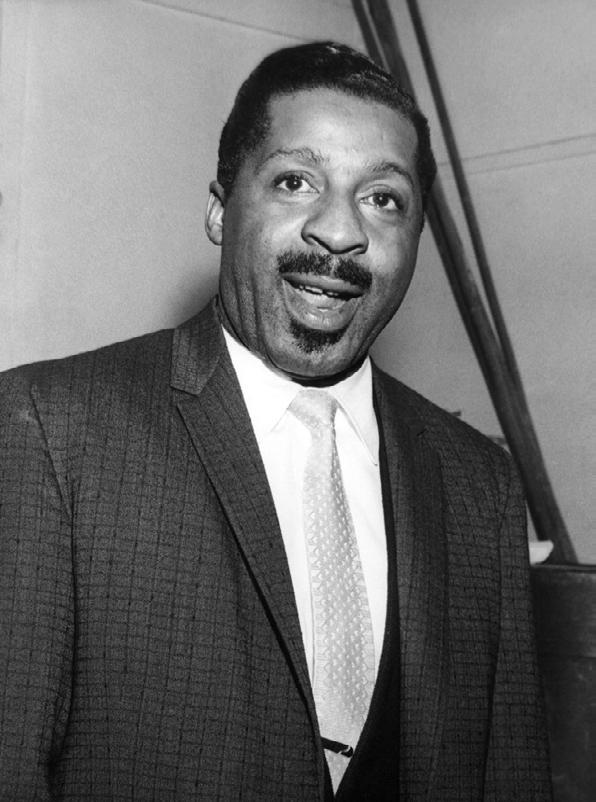
Erroll Garner’s Centennial
Appreciating His Unpredictability and Innate Improvisational Spirit
BY ALEX LEVIN
“Under his fingers, the most obvious tunes are deconstructed, reimagined, restructured, reharmonized, reconstructed, and reanimated.”
Some jazz pianists are so stylistically coherent that the mere mention of their names evokes their sound in our imagination. It’s a rare achievement to play so individualistically that your name evokes your sound, your touch, the joy and sparkle of your playing. Erroll Garner is the rarest of birds: a true, innate, ceaselessly ‘deelightful’ genius of music. Perhaps this is what Clark Terry
meant when he said of Garner, “The man was complete. He could do it all.” The smile on my face as I sit here writing this and listening to Garner’s catalog of recordings attests to the ways in which he did, in fact, “do it all,” and what a joy and an honor it is to listen and learn from this giant of jazz.
Born on June 15, 1921, in Pittsburgh’s Hill District, Garner was gifted with innate talent. He took piano les-
08 JUNE 2021 JERSEY JAZZ
NJJS.ORG
sons from the age of six, although he had demonstrated proficiency on the instrument by the age of three. By age 11, he was playing on Allegheny river boats. This bit of biographical information is perhaps most interesting when you imagine the chugging, rhythmic heart of a river boat engine and compare it to the rhythmic pulse of Garner’s music, whether as a solo pianist or with his unbeatably burning trio.
As a pianist, I am most excited to talk about Garner’s concept—by which I mean the unique approach to his instrument as well as the stylistic traits of his playing. For jazz musicians, their concept is the summation of their art—their unique, idiosyncratic language. Famously, many of Garner’s recordings begin with rhapsodic and sometimes wittily arch solo introductions. Like the opening pages of novels by Toni Morrison, James Joyce, or William Faulkner, you don’t
really know what world you’ve wandered into at the very beginning of a song. Garner builds suspense in his introductions—you know the swing is coming, but you don’t know if he’s coming in with a luxurious ballad tempo (a left hook, metaphorically speaking), a hopping medium tempo (Garner’s right hook—his dominant mode and, arguably, his most swinging place), or one of those faster tempos that nobody plays like Erroll Gar-
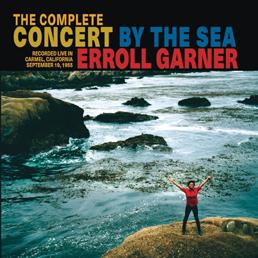
“
ERROLL NEVER SAID WHAT HE WAS GOING TO PLAY OR WHAT KEY, JUST STARTED PLAYING THE INTRO. ”
ner—like his rollicking take on George Gershwin’s “S’Wonderful” from his masterpiece of a record, Concert by the Sea (Columbia Records: 1955). Those introductions, by turns, set the scene for his listeners and mislead us: they are a Wonka-esque world of imagination, limitless and infinite.
As his bassist, Ernest McCarty, once explained, “Erroll never said what he was going to play or what key, just started playing the intro. He was unpredictable.” Listening again to Garner’s records, it’s that unpredictability and innate improvisational spirit that makes everything feel so fresh and free. There’s also something quite funny about the contrast between some of the enormous, classically-influenced rhapsodies that Garner improvises as introductions to familiar standards.
From a conceptual perspective, Garner is also a master of humor.
Lionel Hampton’s “Red Top,” one of
09 JUNE 2021 JERSEY JAZZ NJJS.ORG
JAZZ HISTORY
the tunes he plays on Concert by the Sea, is full on pastiche: Garner’s solo is loaded with quotes from Charlie Parker’s solos and melody lines, along with a few measures of “All Around the Mulberry Bush,” both of which he plays to audible laughter from the audience. As much fun as those quotes are, it’s Garner’s incredible dynamic control on this recording that really tickles the ear and the heart. We know how loudly Garner is capable of playing, but his dynamic restraint is, to me, just as exciting. His playing ranges from the fortissimo to the pianissimo, sometimes in a matter of seconds. Every one of Garner’s recording features exceptional use of dynamics in his storytelling.
Notably, Garner’s solo recordings are as grooving, swinging, and occasionally funky as his trio’s. Check out his version of Sammy Fain’s “That Old Feeling” from his 1955
Mercury album, Solitaire, and see if you can hold still when he moves into the swing sections. His trademark playful interactions between his left and right hands, sometimes referred to by critics and fellow musicians as “Russian Dragon” or “Gas Pedal” time, accentuate the tempos while revealing the supreme independence of his hands. As we like to say in my own jazz piano trio, we play dance music, and whether he’s playing solo or with his trio, Garner’s music is always danceable, underscored by a consistent, propulsive pulse—the riverboat? The heart?
My last thought about Garner’s concept is about the way he approaches standards. Under his fingers, the most obvious tunes are deconstructed, reimagined, restructured, reharmonized, reconstructed, and reanimated His playing transcends songwriting, in a sense. He
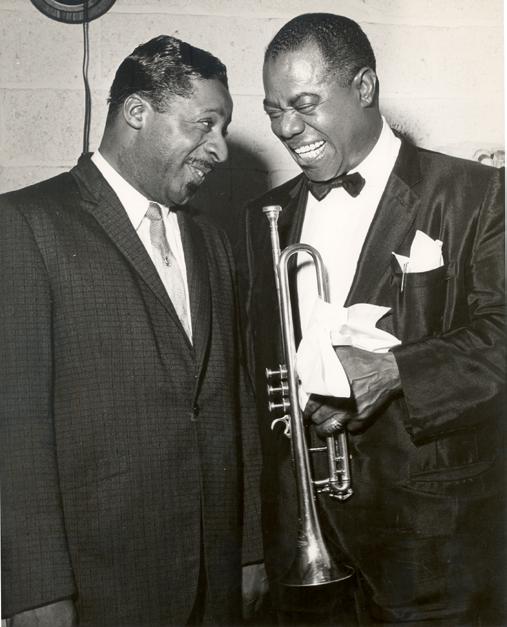
10 JUNE 2021 JERSEY JAZZ NJJS.ORG
PHOTO COURTESY OF LOUIS ARMSTRONG HOUSE MUSEUM
JAZZ HISTORY
Erroll Garner with Louis Armstrong in 1957 in Washington, D.C.

could transform the Liberty Mutual jingle into a masterpiece of compositional sophistication. Unfettered from the world of sheet music and reading, Garner’s ears, his imagination, and his heart lead the way through infinite variations and landscapes of swing and sound.
As for his “Misty”—What can I say that hasn’t been said? A composer myself, I am always seeking to discover a memorable and haunting melody line. Garner’s tune, now inseparable from his fame and legacy, is the gold standard of standards. To think, you can ask any gigging pianist to play “Misty,” and, unless they have played the song so, so many times as to feel that they have exhausted their creative resources, they will inevitably smile and shake their head as they recall the melody and harmonies in the song, and mutter, with co-mingled awe and jealousy, “Great tune …” He wrote and recorded about 200 such great original tunes over the course of his career.
We are lucky to live in the age of YouTube, where you can easily find entire concert performances by Garner, as well as clips from television in the ‘50s, ‘60s, and ‘70s. He was one of the
most frequent guests on talk shows, especially those hosted by fellow jazz pianists like Steve Allen and Dudley Moore, who were eager to bring Garner’s music to a wider audience.
I met up recently with some friends, and we traded stories about Garner and his records. Everyone has deep associations with his music. For those of us of a certain age, his sound is so familiar, he feels like a member of our families. He passed away in 1977, but I turn back to his recordings to remember that he is, in fact, very much with us today.
Alex Levin is Head of the English Department at Philadelphia’s Germantown Friends School and a working jazz pianist. His most recent self-produced album is A Sunday Kind of Love, released last year.
(See “English Teacher and Jazz Pianist”, Jersey Jazz, January 2021).
11 JUNE 2021 JERSEY JAZZ NJJS.ORG
JAZZ HISTORY








Are you a jazz fan and love to cruise?
If you are a fan of Swing, Dixieland, Classic Jazz, Chicago Jazz, Traditional Jazz, in fact just about any style which emerged during the first half of the 20th century, plan to attend JazzFest at Sea - presented in a private jazz club atmosphere limited to 200 guests! Our cruise will be departing roundtrip Port Canaveral (Orlando) to the Bahamas and Mexico on the MSC Divina for 7 - nights of jazz and fun.
Take a look at what you get!
Private Performances Every Eve ning
Private Afternoon Performances on Sea Days and some Port Days
Mix & Mingle Open Bar Cocktail Party
Join our JazzFest Jammer sessions if you play an instrument or sing!
Don’t wait – our space is limited due to capacity restrictions!


October 3 -10, 2021
Join us for one of the few live jazz events in 2021. We are sure you need something to look forward to so call us today or check out our website !
www.jazzfestatsea.com
(800) 654 -8090
We will be following all CDC and cruise line COVID guidelines that may be in place during our sailing!
Featuring
Allan Vaché – clarinet John Sheridan – piano
Houston Person – tenor sax Eddie Metz – drums
Warren Vaché – cornet Brian Holland – piano
Danny Tobias – trumpet Charlie Silva – bass
Paul Keller – bass Jim Lawlor – drums
John Allred – trombone Bob Draga – clarinet
Scott Robinson – tenor sax Ted Rosenthal – piano
Vocalists
Banu Gibson Yve Evans
In addition to our internationally acclaimed artists, we will once again be offering more than twenty hours of opportunity for our guests who are amateur musicians to jam in your own JazzFest Jammer sessions led by John Skillman and Mike Evans. Plus, if you would appreciate some instruction and critique during the jam sessions, feel free to ask.
Amazing Caribbean itinerary from Port Canaveral with ports that include an overnight at Ocean Cay Marine Reserve, Cozumel and Costa Maya!
Inside Stateroom only $999*
Oceanview Stateroom only $1099*
Balcony Stateroom only $1299*
Aurea Balcony Stateroom only $1649*
Aurea Suites from $1999*
Yacht Club Suites from $2499*
*Pricing is per person, cruise-only based on double occupancy and includes all taxes and fees. Must book with Cruise & Vacation Depot or approved agency to attend private performances. Deposit is $400 per person and is due at the time of cabin selection. Fares and performers subject to change. Please be advised the performance venue is non -smoking for all guests.
A Special Musical and Personal Relationship That Bridges a Seven-Decade Age Gap
“I’m 19, and He’s in His 90s. That’s What I Love About Jazz; There’s No Age Discrimination.”
BY SANFORD JOSEPHSON

Ninety-three-year-old Bill Crow remembers when he first started playing professionally and would attend a jam session. “I didn’t own a bass,” he recalled, “so, I would wait until the bass player was tired. Then, I would borrow his. The bass player would get tired because there was one bassist and 10 saxophonists.”
“What I love most about playing with Bill Crow,” said 19-year-old keyboardist Leonieke Scheuble, “is that it’s 50 per cent playing and 50 per cent stories. He told me about playing with Stan Getz when the string on his bass broke, so he took one from under the piano. He also told me he knew Cy Coleman before he was a composer. He’s introduced me to tunes from the ‘20s. These are experiences you can’t get anywhere.”
Leonieke’s father, 58-year-old drummer Nick Scheuble recollects playing with Crow when Scheuble
13 JUNE 2021 JERSEY JAZZ THREE GENERATIONS OF JAZZ
PHOTO BY CYDNEY HALPIN
THREE GENERATIONS OF JAZZ
and his family lived in the Netherlands in the early 2000s. In 2006, they played together with baritone saxophonist Carl Maraghi for a Gerry Mulligan tribute at the Two River Theater in Red Bank, NJ. Two years later, when Leonieke was six years old, she saw her father and Crow play at the Cornerstone in Metuchen. In November 2015, all three of them performed together professionally for the first time at the Hyatt Regency Hotel in New Brunswick, NJ.
Billed as “A Night of Soul Jazz”, by the New Brunswick Jazz Project, it was Leonieke Scheuble & the Generations of Jazz Trio with Nick on drums, Crow on bass, and special guest Bill Easley on tenor saxophone.
That was the beginning of a special relationship that bridges a generation gap of seven decades. During the pandemic, the three have been meeting in the Scheubles’ garage or back-
yard in Rockaway, NJ, to play music and, of course, to listen to Crow’s stories. “We get together to play,” said Crow, “to try to keep our chops.”
Nick Scheuble elaborated: “Most of the arrangements from Bill are trio arrangements. We’re also developing quintet arrangements. Bill’s bass playing is really unique. I can’t put my finger on it exactly. There’s a certain kind of drive he has to his bass playing. It’s a certain kind of conviction to the beat, a strong pulse. Each note seems to have a forward motion. There’s an almost percussive attack to each note. Even slow pieces have a life to them, they feel alive.” Added Leonieke: “When you hear him, you know it’s Bill Crow. We treasure every minute with him.”
The role of the bass, in Crow’s opinion, “hasn’t really changed that much. But, starting with Scott LaFaro, the bass had the option of not
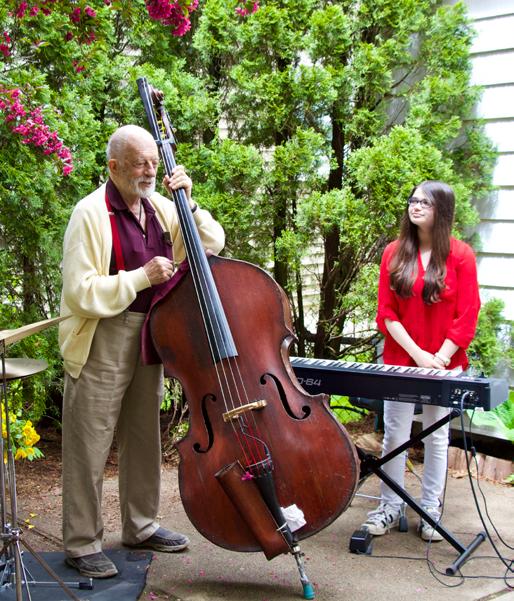
14 JUNE 2021 JERSEY JAZZ NJJS.ORG
PHOTO BY CYDNEY HALPIN
THREE GENERATIONS OF JAZZ
playing 4/4 all the time. Bass players, though, have gotten so much better. They’re finding a way to set the bass up so they can play faster. The strings are closer to the finger board. And, amplification has helped out.”
The pulse of Crow’s bass playing, Leonieke pointed out, is particularly apparent on the 1960 Verve album, Gerry Mulligan And The Concert Jazz Band At The Village Vanguard. Nat Hentoff’s liner notes, describing the performance of Art Farmer’s “Blueport”, wrote that, “Bill Crow’s bass solo leads into a crackling series of exchanges between Gerry Mulligan and Clark Terry.”
Another of Crow’s stories evokes his days in the 1950s, playing with pianist Marian McPartland and drummer Joe Morello at the Hickory House on New York’s 52nd Street. McPartland, he said, “liked to play in all the keys, and some of them were really
Leonieke Scheuble & the Generations of Jazz Trio
will be performing from 7-8 p.m. at the NJ Jazz Society’s June 26 Virtual Social, streaming on the njjs.org website as well as the NJJS Facebook page and YouTube Channel.
hard. Some of them were really finger busters. All the musicians would come and hang out with us. Duke Ellington’s publicity man, Joe Morgen, told the Hickory House he would get them mentions in Walter Winchell’s column if the Ellington band members could eat there (for free). So, we saw a lot of Duke, and sometimes Marian would get him to sit in.”
One night, Dave Brubeck and Paul Desmond came into the Hickory House with the intent to recruit Morello for Brubeck’s quartet, which they did. “I advised Joe not to take
that job,” Crow said. “I said, ‘’If you go with Dave Brubeck, you’re going to become famous, and your price is going up, and no one’s going to be able to afford you.’ That’s what happened, but it worked out well for him.”
I first saw the Scheubles and Crow play together in August 2019 at the Jazz Arts Project’s Jazz in the Park series in Red Bank. Leonieke led a quintet that also included tenor saxophonist Adam Brenner and trumpeter Joe Maganarelli. “This is the first time playing with my own quintet,” she announced, and then she
proceeded to guide the group of seasoned veterans through a selection of hard bop standards from the 1950s including Bobby Timmons’ “Dat Dere”, Horace Silver’s “Senor Blues”, and Nat Adderley’s “Work Song”.
“I grew up hearing Lee Morgan, Art Blakey & the Jazz Messengers, and Clifford Brown,” she told me. “Hard bop has a blues aspect, and I’ve always gravitated toward tunes that are bluesy.” Crow feels it’s “nice to play with Leonieke,” not only “because she’s so young,” but also because “we all love the same music.” The veteran musicians she plays with, Leonieke said, “are legends. But one thing I’ve noticed is we’ve all had similar influences. It’s amazing to play with someone like Bill Crow. He knew people like Billie Holiday and Sarah Vaughan. I’m 19, and he’s in his 90s. That’s what I love about jazz; there’s no age discrimination.”
15 JUNE 2021 JERSEY JAZZ NJJS.ORG
THREE GENERATIONS OF JAZZ
On July 1, the trio of Leonieke, Nick, and Bill will be playing from 6-8 p.m. at 5 Eastman St. in downtown Cranford, NJ, and from 6-7 p.m. on July 26, Leonieke will bring her hard bop/soul jazz quintet to the Jazz Forum Summer Festival at Gourdine Park in Ossining, NY. Adam Brenner will be on tenor saxophone, and Rick Savage will be on trumpet.
Leonieke, said Savage, is “a very talented young pianist who has a hunger to learn all about jazz music. All musicians benefit greatly from acquiring mentors. Louis Armstrong had King Oliver; Freddie Hubbard had Art Blakey. Leonieke has a whole stable of them, starting with a highly talented jazz musician father in drummer Nick Scheuble and an entire family that loves music. Add that to the sublime musicianship, friendship, and jazz history played in every note of Leonieke’s

other mentors, such as Bill Crow, Dr. Lonnie Smith, and Bill Charlap.” Sometimes, Leonieke also plays with bassist Tim Givens, a member of the New York Electric Piano jazz band and the Cecilia Coleman Quintet.
Finishing up her first year in the Jazz Studies program at William Paterson, Leonieke is in four ensem-
bles, two of which are led by Charlap, Director of Jazz Studies. “Six hours of instruction with him!” she exclaims, “an unbelievable experience.” Added Nick, “He’ll say stuff like, ‘Dick Hyman sent me this.’ He’ll tell her stories about composers. She loves it, and he knows she loves it.” Pointing out Leonieke’s “love of the blues and passion for swing,” Charlap added that she “always zeroes in on the rhythm section. She is a humble and dedicated student of the music, and it is exciting to witness the expansion of her artistic development.”
As a teenager, Nick was drawn to the drumming of several musical heroes including Gene Krupa, Buddy Rich, Sam Woodyard, and Morello. Later influences were Max Roach, Roy Haynes, Elvin Jones, and Tony Williams, as well as the “groove drummers” such as Gus Johnson and Grady Tate. He graduated from
William Paterson in 1991, having studied under drummer/educator Dr. John Riley. Throughout his career, he has played with a long list of jazz luminaries including saxophonists Don Braden and Eric Alexander and keyboardist Mike LeDonne, who is Leonieke’s private teacher.
The sessions at the Scheuble home, according to Nick, have “turned into an event, a jazz hang. Everybody wants to play with Bill.” Among those who have dropped by: pianists David Braham and Tomoko Ohno; guitarists Ilya Lushtak, Flip Peters, and Charlie Sigler; percussionist Chuggy Carter; and trumpeter Savage. Added Leonieke: “Bill always comes an hour early. We get pizza with meatballs. We play tunes and talk. And, we have coffee. He likes a dash of Kahlua in his coffee.”
See Bill Crow’s “From the Crow’s Nest” on page 33
16 JUNE 2021 JERSEY JAZZ NJJS.ORG
PHOTO BY CYDNEY HALPIN
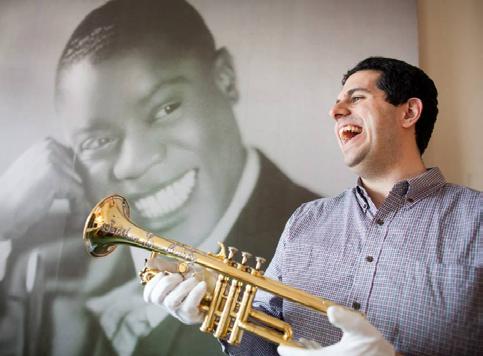

MetuchenArtsCouncil.com
New Jersey Jazz Society
NJJS.org
METUCHEN ARTS COUNCIL partners with NEW JERSEY JAZZ SOCIETY presenting Jazz Education
RICKY RICCARDI
Trumpeter, vocalist, actor Louis Armstrong (1901-1971), whose career spanned 50 years, was one of the most prominent, influential and commercially successful jazz musicians of the 20th Century.
Presenter Ricky Riccardi is the Director of Research Collections for the Louis Armstrong House Museum in Queens and is the “World’s Expert” on Louis Armstrong. His new book is Heart Full of Rhythm: The Big Band Years of Louis Armstrong.
Louis Armstrong 101: The Wonderful World of Louis Armstrong FREE LIVE STREAM EVENT
Sunday, June 13 - 3pm Donations Appreciated

Register Here
PHOTO BY YONI BROOK
With Blue Note Album
on
Horizon, Saxophonist’s Career Continues to Escalate
“One of the Foremost Musician/ Composers of Her Generation”
BY SANFORD JOSEPHSON
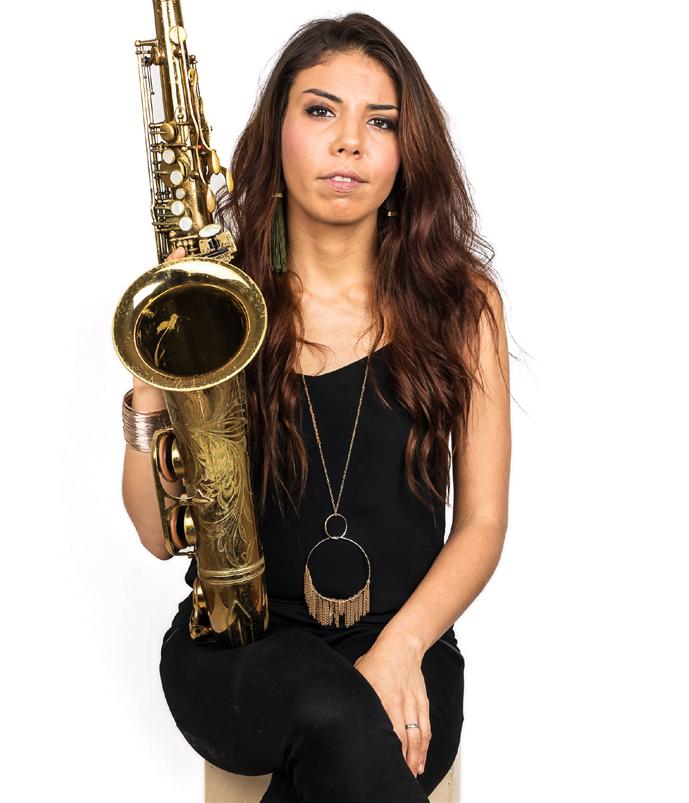
Tenor saxophonist Melissa Aldana was on a roll when the pandemic shut everything down in early 2020. She received a Grammy Award nomination for Best Improvised Solo on her composition, “Elsewhere”, from her 2019 Motema Music album, Visions. AllAboutJazz’s Friedrich Kunzmann called Visions, “a highlight of the year,” adding that Aldana’s playing “is subtle and elegant and of a highly melodic nature ... ” And, Aldana was a charter member of pianist Renee Rosnes’ Artemis, the allfemale septet that caused a sensation at the 2018 Newport Jazz Festival, leading to a signing of the group by Blue Note Records for a 2020 album debut (Jersey Jazz cover story, March 2021). Artemis recently received a 2021 Jazz Journalists Association Award for Best Mid-Sized Ensemble.
Now, as the jazz world eases out of the pandemic, Aldana is looking
18 JUNE 2021 NJJS.ORG
ALDANA
MELISSA
PHOTO BY HARRISON WEINSTEIN
MELISSA ALDANA
forward to her own first album with Blue Note. She started recording it last month for an early 2022 release date. (Aldana has departed Artemis, succeeded by tenor saxophonist Nicole Glover). When Don Was, Blue Note President, announced Aldana’s signing, he described her as “one of the foremost musician/composers of her generation. Her vibrant artistic vision, mastery of her instrument, and her deep groove make Ms. Aldana a perfect exponent of the Blue Note ethos.” In a news release, Aldana said, “It feels unreal that I was signed to Blue Note . . . I feel extremely honored to be a part of the label and a part of the legacy. It means so much to me.”
Born in Santiago, Chile, the 32-year-old Aldana learned about jazz and the saxophone from her father, Marcos Aldana, a professional saxophonist. “The most important thing my dad taught me,” she said, “was disci-
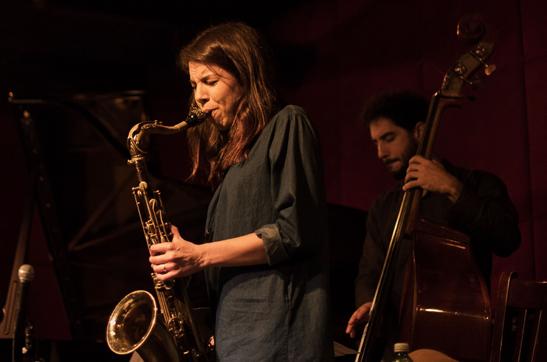
pline and patience.” Aldana started out on alto sax, and her early heroes were Charlie Parker and Cannonball Adderley. There are four tenor players who “are the people who mean the most to me: Don Byas, Benny Golson, Sonny Rollins, and Mark Turner.” Turner described Aldana to Jersey Jazz as “an excellent saxophonist with a strong work ethic and curiosity which can be heard in her music. You can hear the fight and the mystery in her. She is
level headed regarding her trajectory, meaning she can roll with life’s punches. She’s got what it takes to succeed.”
In 2005, Aldana met pianist Danilo Perez while he was on a tour in Chile, and he invited her to play at the Panama Jazz Festival. He also helped her get auditions with music schools in the United States. “Danilo Perez and his wife—those are the people who opened their doors to me,” she said. “I stayed in their
house, and they helped me get a full scholarship to come to the States.”
The scholarship was to the Berklee College of Music in Boston; she graduated in 2009. Aldana’s main teacher there was saxophonist George Garzone. “I learned so much from him,” she said, “seeing him waking up at 6, teaching all day, and then going to play a gig.” Garzone, like Perez, saw Aldana play while on a trip to Chile. “I could tell she had her act together,” he said. “She was playing straight ahead jazz. I showed her some extensions of what she was already doing. She was a hard worker and really into it. She stayed with me for most of her time at Berklee. She’s one of the most conscientious students I have met.”
Aldana’s first album, Free Fall, was recorded on the Inner Circle label in 2010, followed by Second Cycle two years later. In 2013, she became the first female instrumentalist and first South
19 JUNE 2021 JERSEY JAZZ NJJS.ORG
Melissa Aldana at the Jazz Standard
PHOTO BY PABLO VALLE
MELISSA ALDANA
American musician to win the Thelonious Monk International Jazz Saxophone Competition (Her father was a semifinalist in 1991). A recording contract with Concord Jazz was part of the prize, resulting in her third album, Melissa Aldana & Crash Trio. Reviewing that album, London Jazz News called Aldana, “a distinctive and appealing voice. We are sure to hear more of her.”
Given the restrictions of the pan-
demic, Aldana has tried to stay as busy as possible. Last October, she was part of a virtual “Jazz For America” concert, a benefit for the Biden campaign, held at City Winery Hudson Valley in Montgomery, NY. Organized by pianist Aaron Goldberg, other performers included guitarist John Scofield; vocalist Jazzmeia Horn; saxophonists Joe Lovano (her ensemble teacher at Berklee), Ravi Coltrane, and Miguel

“
A DISTINCTIVE AND APPEALING VOICE. WE ARE SURE TO HEAR MORE OF HER. ”
Zenon; bassists Christian McBride and John Patitucci; pianist Fred Hersch, harpist Brandee Younger, and trumpeter Sean Jones. Co-hosts were vocalist Dee Dee Bridgewater and future second gentleman Douglas Emhoff.
On April 23 of this year, Aldana led a quintet playing music from Visions as part of the Jazz Standard’s “The Flip Sessions” virtual concert series. That was followed by a performance of McCoy Tyner’s “Passion Dance” as part of International Jazz Day on April 30. Playing with her were drummer Antonio Sanchez, alto saxophonist Rudresh Mahanthappa, bassist Massimo Biolcati, and pianist A Bu.
On May 16, she was part of the twoday Downtown Jamaica Jazz Festival on the lawn of the Jamaica Performing Arts Center in Jamaica, Queens. Coming full circle, Aldana is now a jazz educator. She has joined the faculty of the New England Conservatory Jazz Studies department for the 2021-22 academic year. Her teaching, she said, will just be “part-time because I feel I am at a point in my process where the most important thing for me is to play and get that kind of experience. And, also, I feel like the experience of playing and growing as a musician is the most important thing I can give to a student.”
20 JUNE 2021 JERSEY JAZZ
PHOTO BY FANNY BELSO

A Jersey Jazz Interview with Ed Cherry
BY SCHAEN FOX
The Dizzy Gillespie ‘alumni association’ is a large group, and one of the most prominent and esteemed members is guitarist Ed Cherry, who played with Gillespie for 14 years. In a review of Cherry’s 2016 Posi-Tone album, Soul Tree , DownBeat ’s Bill
Milkowski described him as “an irrepressibly swinging guitarist ... in that lineage that includes ... Pat Martino, George Benson, Grant Green, and Wes Montgomery.”

22 JUNE 2021 JERSEY JAZZ NJJS.ORG TALKING JAZZ
JJ How did you get the gig with Dizzy?
EC I moved to New York, when I was 21, and I got the gig with Dizzy the same year. It was just that I knew Rodney Jones. Rodney had been in the band for about two or three years, then he decided to leave. I was surprised because Dizzy could have anybody he wanted, but I got the call. I made about a 15-20-minute rehearsal with Dizzy; Mike Longo the long-time pianist with Dizzy; and Ben Brown, Dizzy’s bass player. When I walked into audition, Dizzy recognized my face, “Oh, yeah, I know, you.” He recognized me from hanging out backstage at the Village Gate or wherever they played. We played a couple of songs and that was it. I think we played “Night in Tunisia,” and one other song, then Dizzy just cut it short. He brought me into the bathroom at the apart-
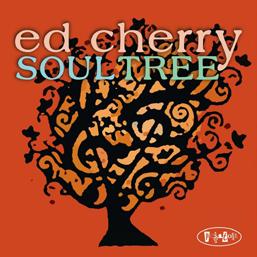
ment, closed the door, pulled out this wad of cash and gave me five $100 bills. He said, “Go get yourself some clothes. We’re leaving next week.” I had been starving in New York. I hadn’t seen $500 ever up to that point. That was it. I was in the band. My first gig was on his birthday, October 21, 1978. I figured I’d be in the band a couple of weeks, and then I’d be kicked out, but many years later, I was still in the band.
“ MY DAD STARTED PLAYING GUITAR WHEN I STARTED PLAYING GUITAR, LIKE, AROUND SEVENTH GRADE. ”
JJ How much in a year would be with Dizzy?
EC Most of it. For the first four or five years that I was in the band, we were working constantly. And when we weren’t working, Dizzy would go off and play with a college big band. doing a master class or whatever, wherever. We’d go out for a month of one-nighters, come home for maybe two or three days, and then go out for a week, come back for a couple of days, go out for another month, maybe come back for a week, and go back out again. It was crazy. He was about 60 or so when I joined the band, and he never complained, so we didn’t either. He seemed to thrive on the schedule and the traveling. He didn’t like to be home very long at all.
JJ What was life like on the road?
EC You get up at, like, seven in the morning, go to the airport—that could be a 20-minute drive, it could be a
23 JUNE 2021 JERSEY JAZZ NJJS.ORG
TALKING JAZZ
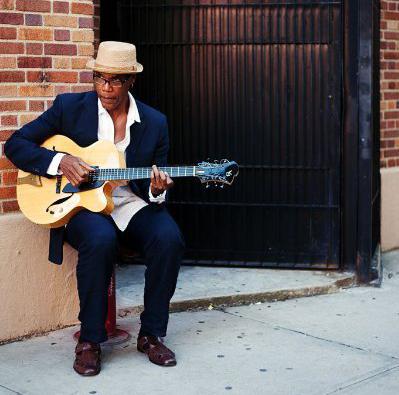
two-hour drive. Then you’re traveling all day, and you show up in time for a soundcheck and maybe something to eat. Then you play the gig and you’re usually done by 10 or 11 at night, if it’s a concert. Then you go back to your hotel room, and you do it all again the next morning. That would last for a month or a week at a time. Every day. You ate what you could get. You try to pick the best food that you can get while you’re traveling. But a lot of times you can’t get good food stopping at these roadside places. It’s usually burgers, bad steak or fish. You try to try to pick the best of the worst.
JJ Was it Dizzy’s influence that got you to move to New Jersey?
EC It was more about we got more space for the money. My wife had a daughter from a previous marriage, and space was limited in New York. We moved to Fort Lee in 1983 and
had the whole top of a house. That was nice. That Dizzy lived in Englewood, close by, was convenient. (Cherry now lives in the Bronx)
JJ What are your best memories of your time with Dizzy?
EC Oh, just the general camaraderie in the band. From 1978 until he passed, I was always in the band. He changed drummers and bass players two or three times and added this or that, but I was the one guy who was in the band through the whole thing. There was a period from ‘83 until late ‘85 when I wasn’t in the band. He started using piano again and hired Walter Davis Jr. Walter was in for a couple of years but then wanted to do more of his own concerts. When Walter left, Dizzy called me back in. So, it’s just like a general memory of how everybody was cool. All the guys in the band got along and tried to make the music happen.
24 JUNE 2021 JERSEY JAZZ NJJS.ORG
JAZZ
TALKING
And we enjoyed Dizzy’s company. Dizzy was a great band leader; he wasn’t a tyrant or got funny with the money or left us stranded. I hear all these horror stories about different band leaders doing that to the guys, but Dizzy was not like that. He was very professional, and took care of his band. We didn’t have to worry about any of that. We just had a good time traveling. It was tough when you work that much, late nights, early mornings traveling all day, but it was fun. We tried to have as much fun as possible. Being a part of Dizzy’s band, you’d be in close proximity to other cats of Dizzy’s stature. They would either guest with the band or hang out backstage. I would have never been able to meet Milt Jackson unless I was playing with Dizzy. Milt Jackson, James Moody, Dexter Gordon, Art Blakey— all these guys had high respect for Dizzy. They would either come to the
“ I HEARD THAT GEORGE BENSON PLAYED WITH MILES DAVIS, SO MILES SMILES WAS THE FIRST MILES DAVIS RECORD I BOUGHT. ”
concerts to hang backstage, or they played with him on a couple of songs.
JJ Do you recall how you learned that Dizzy had cancer?
EC Just being on the road with him. We saw the physical decline—losing weight, loss of balance. Then he was diagnosed with pancreatic cancer. He played for as long as he could, then the doctors kept him at home. On different occasions, Mike Longo would go play with him at home. A couple of times, I brought guys over to his home
for a little jam session, so that he could play, and that was fun. Then after his health deteriorated even more, he got sent to the hospital. And that was it.
The day that Dizzy died, my wife and I went to visit him. He was sleeping in the easy chair in his room breathing very shallow breaths. We didn’t want to wake him up. We were there for about 10 minutes organizing his room. My wife brought flowers, and we called Dizzy’s wife to let her know that we were there, and he seemed okay. As we were leaving,
James Moody and Jon Faddis were coming in. They called and told me that after we left, Dizzy passed away.
JJ Do you come from a musical family?
EC Well, let’s start with my parents. My dad started playing guitar when I started playing guitar, like, around seventh grade. We both went to the music store and had the half-hour guitar lessons. He is still in that first grade book. Anyhow, he liked jazz. His favorite guitar players were Grant
25 JUNE 2021 JERSEY JAZZ NJJS.ORG
TALKING JAZZ
Green and Kenny Burrell. He would play those records when I was a kid. He also liked Charlie Parker, Dizzy Gillespie, and all the usual suspects.
My mom played very little classical piano. She could slowly sight-read her way through some stuff, but she wasn’t really a strong player. She’d liked music and took me to concerts—Broadway plays, operas and things like that when I was a young kid. At the time, I wasn’t really into it, but looking back, I’m glad that she did because she made me aware of these other kinds of music. No one else that I know played any music.
JJ I read where you said you didn’t really start listening to your dad’s record collection until you were in high school.
EC Yeah, I started investigating his Thelonious Monk 78s, Charlie Parker LPs, stuff like that. My dad was a
fan of the music, and started collecting records when he was in college. He went to Howard University. He and his buddies would go see Charlie Parker and all of those guys at the Howard Theater. The Howard Theater was one of the big places to play.
JJ Did you just get interested on your own or did someone prompt you?
EC I just started getting interested on my own. Maybe I saw George Benson on TV. Now, this is 1971 or ‘72, PBS had jazz on TV from time to time, and they would play live. I remember seeing George Benson, and I think Earl Klugh was in his group. And, I remember seeing Larry Coryell with his band and I was like, “Wow, that was interesting.”
Up to that point I was playing R&B, rock, blues, Jimi Hendrix and all that stuff. I wanted something more. Af-
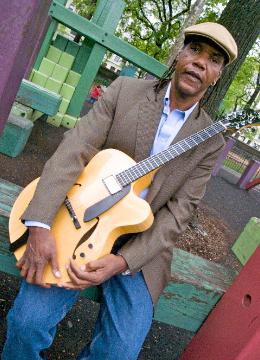
“ I WANTED SOMETHING MORE.”
ter I saw those guys on TV, I started slowly buying jazz records. I heard that George Benson played with Miles Davis, so Miles Smiles was the first Miles Davis record I bought. Then I heard that Larry Coryell played with Gary Burton. So, I bought Duster, one of the first jazz-rock records. They were playing original music, but it incorporated over-driven guitar and things like that.
JJ I read that Bruce Johnson was very significant for you. Why didn’t he record much?
EC He didn’t really care about that aspect of the music business. He rarely gigged. He had a lot of students and made most of his money that way. And, he did a lot of side hustle things to keep money coming in. He was a brilliant guy, very opinionated. He could talk about a lot of different subjects: music, photography, art; and he was a genius guitarist, He was
26 JUNE 2021 JERSEY JAZZ NJJS.ORG
JAZZ
TALKING
very inspiring to me. When I first met Bruce, I was 19 or 20 years old. He was great to be around at that age.
I studied with Bruce from about 1976 until I joined Dizzy’s band in ‘78. A lot of different guys took lessons from him like Vernon Reid, the rock guitar player. Vernon Reid had this band called Living Color. And they were popular in the ‘80s. Kevin Eubanks took some lessons from him. So, we’re all kind of coming from Bruce Johnson.
JJ I read that you almost attended Berklee. How close was almost?
EC: Well, I was about to do my first year, but I got a call to go on the road with a band, and I decided to do that instead. I went on the road with an oldies group called Fred Parris and the Five Satins. They gave me my first experience on the road, and I’m glad I did it. My parents were disap-
pointed that I didn’t finish my schooling, but they saw that I was playing music, making decent money and traveling; so they were supportive.
JJ I didn’t expect to hear the name The Five Satins.
EC It was a great band. They sounded good, and they put on a good show. And, they didn’t get all crazy with alcohol and drugs. They made a good impression for us, as the young backup band. Plus, from time to time, we would get to back up Bo Diddley or Chuck Berry or The Drifters. These guys oftentimes would just show up with no band, so we would back them up for maybe three songs and then they’d go. I can’t say that I got to meet any of them for any length of time, other than them telling us what key each song was in. That was it, but we were all kind of starstruck. Bo Did-
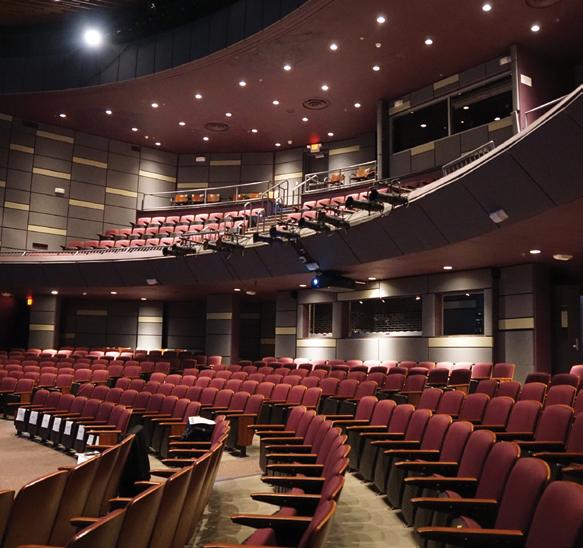
NJJS.ORG 27 MAY 2021 JERSEY JAZZ
JAZZ grunincenter.org Grunin Center Box Office Hours Mon.-Fri. 10:00am-5:00pm 732-255-0500 College Drive P Toms River, NJ Contact the Box Office two weeks prior to any show to arrange for disability and accessibility services. The Grunin Center and Ocean County College Support the Arts THE SHOW WILL GO ON
TALKING
“ ALL THESE GUYS WERE FREE ON SATURDAY MORNINGS, SO THEY WOULD TEACH THESE CLASSES. ”
dley! Wow! It was a good experience. I have nothing bad to say about it.
JJ It was about six or seven years between high school and joining Dizzy. What else were you doing for those years?
EC I was with The Five Satins until about ‘75. Then I started going in and out of New York to Jazzmobile.
They had a Saturday afternoon program where you could go for next to no money and study with masters of jazz music. I would study with Ted
Dunbar—great guitar player—or Wally Richardson, another great guitar player. I remember Jimmy Heath and Jimmy Owens were there. Bob Neloms was the piano teacher. He played with Mingus for a long time. All these guys were free on Saturday mornings, so they would teach these classes. I know they put on concerts now. I don’t know if the school thing is still active, but it was a great situation. In ‘76 I met Rodney Jones, so I started coming into New York even more to hang with Rodney or to see Dizzy.
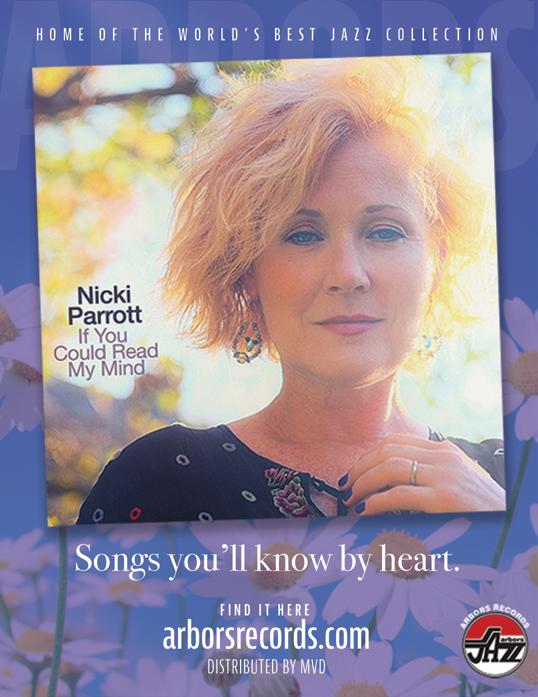
NJJS.ORG 28 MAY 2021 JERSEY JAZZ
TALKING JAZZ
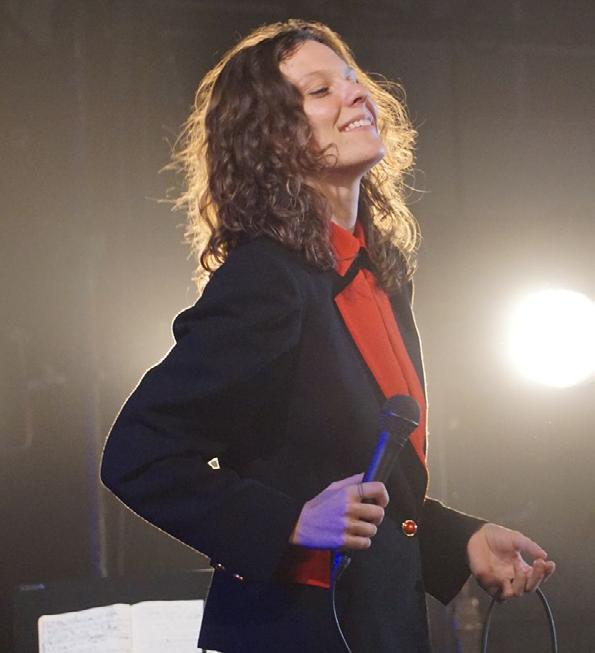
Lucy Wijnands, Ella Fitzgerald Jazz Vocal Competition Winner
“I Knew She Was Special. There’s Depth in Every Note She Sings.”
BY SANFORD JOSEPHSON
Contestants in the fourth annual Ella Fitzgerald Jazz Vocal Competition, sponsored by the Blues Alley Jazz Society, were asked to sing three selections from the 1964 Verve album, Ella Fitzgerald Sings the Johnny Mercer SongBook. That request, said Lucy Wijnands, the winner, was “a gift from heaven. Johnny Mercer is absolutely my favorite composer.”
Her three Mercer selections were: “Too Marvelous For Words”, “Laura”, and “Dearly Beloved”. The latter song was not on the album, but
Harry Schnipper, BAJS Executive Director and Owner of Washington D.C.’s Blues Alley jazz club, allowed some flexibility. Once Wijnands began singing, the judges were captivated. Said Alison Crockett, Adjunct Professor of Music at George Washington University: “I saw in her a mature, confident sound with a definitive musical outlook that had me singing with her. If I want to sing with someone, that hooks me every time.” Added Dr. Darden Purcell, Director of Jazz Studies, Voice,
29 JUNE 2021 JERSEY JAZZ
RISING STAR
BY JOHN ABBOTT
PHOTO
RISING STAR
at George Mason University: “Lucy has an exquisite voice with impeccable diction, and her interpretation of the repertoire was highly musical. She has a great career ahead of her.”
Originally from Kansas City, the 23-year-old Wijnands graduated in 2020 from the Conservatory of Music at SUNY Purchase where she was the Ella Fitzgerald Scholar and recipient of the President’s Award of Achievement. In 2016—her freshman year—she appeared in concert at Jazz at Lincoln Center’s Appel Room. She also completed a five-month residency with the Birdland Big Band, directed by David Dejesus, and has performed with trumpeter Jon Faddis and tenor saxophonist Joe Lovano, among others. Now settled in Brooklyn, Wijands is collaborating with vocalist Samara Joy on a June 6th performance at New York’s Cutting Room based on the music of Ella and Sarah Vaughan. Joy
was the 2019 winner of the New Jersey Performing Arts Center’s International Sarah Vaughan Vocal Competition, also known as the Sassy Awards. “We will be singing their classics as duets,” Wijnands said, “with Gadi Lehavi on piano, Mikey Migliore on bass, and Itay Morchi on drums. Samara and I will also be doing an interview beforehand (about Ella and Sarah).”
They previously recorded a YouTube duet of Lerner and Loewe’s “Almost Like Being in Love”, which was recorded by Fitzgerald on the 1963 Verve album, Ella Sings Broadway.
Wijnands is also working on a new self-produced album entitled You’ll Never Walk Alone, inspired by the Rodgers and Hammerstein song from the musical, Carousel. The album is “still very early in the works,” she said, “but my plan is to make it an interdisciplinary album related to my paintings.” The daughter of stride pianist,

Bram Wijnands, and art historian,
Lisa Smith, Wijnands always painted in addition to singing, and her visual art “picked up during the pandemic. My mom said to me, ‘Why don’t you start throwing some paints?’ I became obsessed. Now that I’ve been painting, it has brought me closer to my music. The album will have a catalog with sketches and lyrics. So, it will be CD/
vinyl/catalog.” Her goal is to release a single of “You’ll Never Walk Alone” in July or August and the album by the end of the year or in early 2022.
“After a year of nothing going on, I look forward to doing live performances again,” she said. With the album, her goal “is to remind artists that they have a place in this unstable world. It can be easy to feel lost or
30 JUNE 2021 JERSEY JAZZ NJJS.ORG
“Juicy Fruit” by Lucy Wijnands
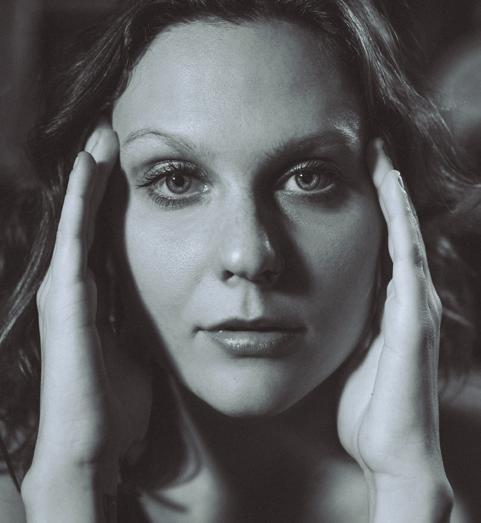
“ SHE DOESN’T SING ANY BAD NOTES. ”
discouraged, but art represents who we are, what we care about, and what we’ve been through. You’ll Never Walk Alone celebrates music, painting, singing, togetherness, and much more.”
Both of Wijnands’ parents have been major influences on her. “My father,” she said, “is a master of the stride piano. He also builds renaissance era instruments and plays accordion, bass, and guitar. But the piano is his master instrument. I grew up singing with him on his gigs in Kansas City.” Though her mother’s specialty is visual art, “she was always singing—Stevie Wonder, funk music. That’s why she was drawn to my dad.”
In 2013, the family moved from Kansas City to Hastings-on-Hudson, NY, in Westchester County. For Lucy and her twin sister, “it was hard—two [teenage] women from the Midwest moving to what was completely different country.” She began taking voice lessons in New York City from singer/ composer/producer Anne Phillips, taking the train into Manhattan every week. Phillips, said Wijnands, was “my complete inspiration, my mentor, a beautiful singer and composer.”
Describing her teaching technique to Jersey Jazz, Phillips said, “The first thing I look for is pitch and time. Obviously, Lucy has both of
NJJS.ORG 31 JUNE • 2021 JERSEY JAZZ RISING STAR
PHOTO BY LUCAS ASENSI
RISING STAR
those. She doesn’t sing any bad notes. She really wanted to learn the American songbook and jazz standards. We really worked on lyric understanding. By the time she was a senior, I went to see her high school production of Les Miserables. When Lucy stepped on the stage, it was like a pro stepped into the cast. She tells a story. She connects with the audience.”
The education at Purchase, Wijnands said, “was great.” She singled out four faculty members who were her primary mentors—pianist Pete Malinverni, Jazz Studies Chair; vocalist Alexis Cole; and trumpeters Faddis and Ingrid Jensen. “They were my squad,” she said. Cole “loved having Lucy in my studio. She would consistently bowl me over with her soulfulness and sincerity. When she would perform, her singing would bring me to tears. She’s also one of the most rhythmic singers I’ve heard.
She kills at up tempo swing and fast samba numbers as well as being an artist of great depth performing ballads.”
The first time Malinverni heard Wijnands, “I knew she was special. There’s depth in every note she sings, and every moment is an honest one. All we did for her was to show her support, put her with like-talented young players and singers and encourage her to uncover all her gifts.”
As for Wijnands’ musical influences, “they span very widely. Ella and Sarah, of course. Eydie Gorme, Judy Garland, and Joni Mitchell are big ones. Judy was who I fell in love with when I was very young and tried to mimic—the first song I sang was ‘You Made Me Love You’. Gorme’s voice was so familiar to me because it reminded me of my voice teacher, Anne Phillips. I got more into Joni in college—I was drawn to her not only for her music but also because she was a painter.”
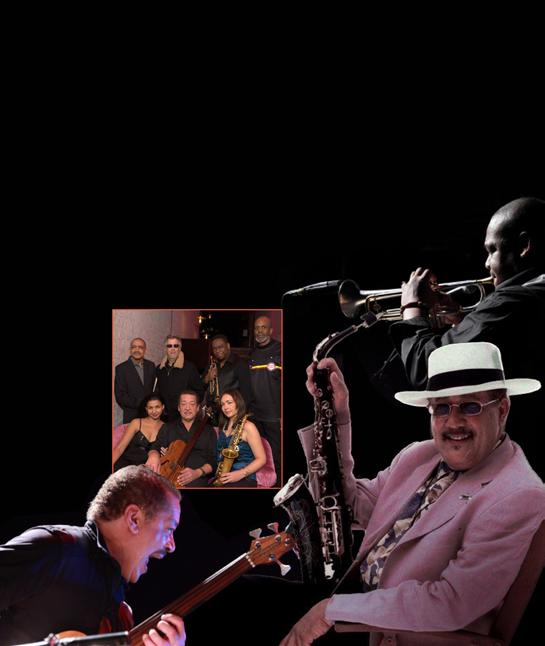
LIVE AT NIGHT PRESENTS
The Dizzy Gillespie Afro–Latin Experience
WITH GRAMMY WINNERS
JOHN LEE AND PAQUITO D’RIVERA
HOSTED BY BOBBY SA NAB RIA FROM WBGO
Listen to WBGO radio June 4th from 9-11 as Bobby Sanabria highlights the Experience Band on his show, The Latin Jazz Cruise.
JUNE 19TH AT 8:00PM
BOX OFFICE Mon-Fri 12-4PM (973-313-2787) sopacnow.org
NJJS.ORG 32 JUNE • 2021 JERSEY JAZZ
FROM THE CROW’S NEST
BY BILL CROW
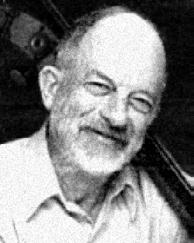
When Eli Dimeff was playing a one-nighter with the Buddy Morrow band, a woman asked Buddy to play “In the Mood.” Buddy politely explained that she had the wrong band, and that he didn’t play that tune. The lady persisted in her request a number of times. Finally, Buddy angrily grabbed his trombone and played the melody to “In the Mood” in a loud, vulgar, staccato manner. The drummer joined in with a heavy backbeat, and the band responded with campy riffs. Suddenly the dance floor, which had been sparsely occupied during the band’s previous numbers, was jammed with patrons happily doing the twist. The band members were laughing so hard they could barely play.
Bill Crow is a freelance musician and writer. His books include Jazz Anecdotes, Jazz Anecdotes: Second Time Around, and From Birdland to Broadway. This column is reprinted with permission from Allegro , the monthly magazine of AFM Local 802.
Peter Landsdowne told me that in the late late 1950s and early 1960s, Maynard Ferguson’s band played at Birdland for at least 16 weeks a year. Alto saxophonist Jimmy Ford would pay Pee Wee Marquette, the master of ceremonies, to announce: “The Maynard Ferguson orchestra ... featuring Jimmy Ford!” as Ford would stroll out from the men’s room as the last musician to take the stand.
Steve Brauner gave me a story his father Buzz once told him. On a big band gig, when the drummer set up his kit, he started to install a stage screw anchor to keep his kick drum from sliding. The stage custodian told him he couldn’t screw into a freshly varnished stage. So, the drummer tied a cord from his kick drum to his throne. He then tied another cord from the throne to some heater pipes
at the back of the stage. No one had told him that the stage was motorized. As the stage moved the horn section slowly forward towards the audience, the anchored drummer was pulled off the back of the stage amid sounds of crashing drums and cymbals, and cursing.
On a gig where the leader was an amateur bass player, guitarist Joe Puma expressed his unhappiness with the bass lines. The leader told Joe that he didn’t need the money but was playing because his doctor had told him that music was good therapy for him. Joe responded, “Your therapy is making the rest of us sick!”
On another occasion, Joe was playing in a nightclub jam session when a guitarist in the audience went up and asked him, “Can I play?” Joe answered, “Do you want my permission, or my opinion?”
33 JUNE 2021 JERSEY JAZZ NJJS.ORG
“ DID YOU HEAR THAT, KIDS? THEY’RE PLAYING WITH CHUCKWAGON JONES.”
Bill Wurtzel once played an orthodox Jewish gig where the host complained that their music was making some men and women dance together. In the orthodox community, such dancing was forbidden. Bill decided that, for that audience, it DOES mean a thing if it ain’t got that swing.
David Hoffman told this story on Facebook: On Ray Charles’ band, we were getting ready to play a gig, and one of the trumpet players was not there yet. Of course, the missing trumpet player had a solo on one tune. So, I played his
solo. Since we played together every night, I knew his playing quite well, and did a very credible job of sounding like him, at least in my opinion. At the end of the concert, as Ray left the stage, he walked by me and said, “Hoffy, I know that was you.”
Johnny Morris was the house pianist at Jimmy Ryan’s on West 54th Street for seven years, playing with Roy Eldridge’s group. One evening, several of Roy’s friends came in to hear him. They moved several small cocktail tables beside the bandstand so they could all sit together.



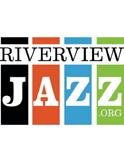


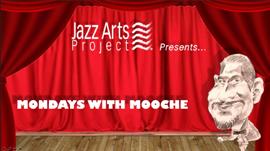
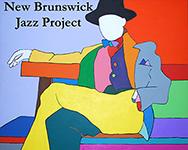

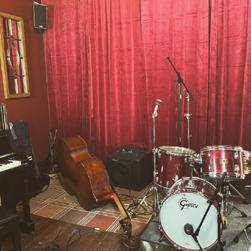

NJJS.ORG A WEALTH OF NEW MUSIC AND EMERGING TALENT IN AND AROUND NORTH JERSEY ! Under the tent / No cover Tavern on George / 361 George St New Brunswick THUR 7-10 & SUN 1-4 (open jam) Bar Bayeux Facebook live stream Wed 7:30 Monday nights No cover Open jams in Jersey City No cover / outdoors Sat & Sun gregoryburrusaroundtown
PLACE Elks Ideal Lodge Englewood NJ Jazz jam returns Tue June 15 / $5 nbjp.org More info: James Pansulla / JazzEducation@njjs.org new music podcast 7 p.m. live stream 34 JUNE 2021 JERSEY JAZZ FROM THE CROW’S NEST
MOORE'S
FROM THE CROW’S NEST
This annoyed one of the waiters. They had taken all the tables from his section. He complained to Johnny, while Johnny was busy playing, saying he was going to tell them all off. Johnny pleaded with him not to do so. “I’ll explain as soon as we finish playing this number.” The waiter was about to insult Ella Fitzgerald, Oscar Peterson, Tommy Flanagan, Bobby Durham, Keter Betts, Connie Kay, Benny Carter, and John Hammond.
Another Facebook post, from Keith O’Quinn. “I was touring with Chuck Mangione in the ‘70s. We had a big concert in Nashville. French horn player John Clark and I grabbed a taxi outside the hotel and told the driver we were going to the Opry House. He was a real friendly southerner and had his two little kids with him in the front seat. He asked, ‘Who do y’all play
with?’ I said, ‘We’re playing with Chuck Mangione.’ He got excited and said to his kids, ‘Did ya hear that, kids? They’re playing with Chuckwagon Jones!’”
Dick Lieb passed along a story from Vinnie Riccitelli. Vinnie had a job for a jazz quartet at a private party, and couldn’t get his regular piano player. He was friendly with Toots Thielemans, who was living in New York at the time and called him to come and play guitar on the job. Toots, the composer of the jazz hit “Bluesette,” was getting a lot of work because of it, but he was open that day and accepted Vinnie’s offer.
On the job, Vinnie decided to stroll the tables. He and Toots, and the bass player began making the rounds. When he asked one table for a request, one of the guests said, “I’ll bet you don’t know ‘Bluesette’.”

NJJS.ORG 35 JUNE 2021 JERSEY JAZZ
Thank You, Curtis Fuller
BY MICHAEL DEASE
I
f you know your jazz music, then Curtis Fuller needs no introduction. You, the reader of Jersey Jazz Magazine, by association, are already hipper than most and know many of the records, venues and tales of this music. The story of Detroit trombonist-turned-“gift to the universe”, Curtis DuBois Fuller, is being celebrated all over the world due to his recent passing at age 86. His impact upon the thousands of musicians in our community is quantifiable by his peerless recorded legacy and certainly palpable to those intrepid explorers who, likewise, chose his challenging instrument. In fact, I am one of those folks, and
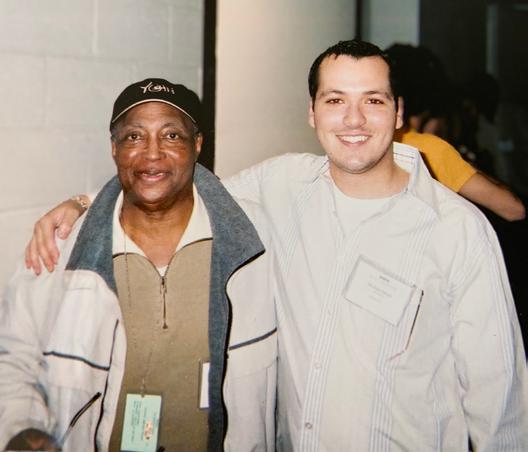
I’d like to give you a little context.
I had been studying the saxophone from 11-17 years of age when my friend put John Coltrane’s “Blue Train” in the car stereo. He said, “Well, listen here Michael. If you are going to study saxophone in college, then you HAVE to know who John Coltrane is.”
So, I listened. After all, I was in the All-State Band and playing professionally around town. This seemed like a good idea, and then that trombone started playing. Big, warm tones, sneakily swinging along. I was blown away and I still am today. I gave up saxophone and switched to trombone the very next day and taught myself to play by learning all of the Curtis Fuller solos on that recording. It was a life-changing moment for me. Curtis Fuller changed my life. As a trombonist, musical disciple, and student of Curtis Fuller, I would
36 JUNE 2021 JERSEY JAZZ NJJS.ORG BIG BAND IN THE SKY
Curtis Fuller, left, and Michael Dease at Betty Carter’s Jazz Ahead program at the Kennedy Center in 2004.
“ HE WALKED THE ROAD AND LIT THE WAY. ”
like to highlight a powerful theme that is hinted at, but not developed in the tributes that I have read.
The theme is gratitude.
Thank you, Curtis Fuller, for meeting the daunting obstacles during your upbringing with positivity and determination so the torchlight of your humanity and artistry could shine brightly for all to see.
Thank you, Curtis Fuller, for making us all lighten up and laugh with your hilarious, clever sense of humor.
Thank you, Curtis Fuller, for showing us how warm, soulful and wise the trombone is capable of sounding.
You showed everyone that the trombone can go anywhere it wants to go, with supreme grace and power.
Thank you, Curtis Fuller, for dedicating your life to playing your music live, in person, night after night, all over the world for as long as you were able.
Thank you, Curtis Fuller, for talking with and embracing us, your audience, fans, and peers.
Thank you, Curtis Fuller, for lifting up younger musicians (like myself and throngs of others) with genuine encouragement and support rather than anything different.
Thank you, Curtis Fuller, for shar-
ing your melodic and rhythmic genius on the bandstand. Heaven lies in your phrasing. Despite the constant temptation of your lightning-fast slide technique, wizardly articulation, and nuance, you avoided any semblance of exhibitive display in your performing.
Thank you, Curtis Fuller, for your service in the United States Army during the Korean War.
Thank you, Curtis Fuller, for leaving the spirit of the blues given to us from our African-American ancestors on every note you played.
Thank you, Curtis Fuller, for leaving the mark of your soul on the lives of those close to you: your family, your musical circle (Javon Jackson, Steve Davis, Joseph Farnsworth, Brad Goode, Steve Turre, and so many more)
Thank you, Curtis Fuller, for showing us all that humility, optimism, and hard work can make dreams come true.
As I take stock of my fami-
ly, students, beloved friends and opportunity to live in the music, I realize that Curtis has helped me to realize my own dreams. He walked the road and lit the way.
Thank you, Curtis Fuller.
Curtis Fuller, an NEA Jazz Master. passed away on May 8, 2021, at the age of 86. Michael Dease, Associate Professor of Jazz Trombone at Michigan State University, studied under Fuller at Betty Carter’s Jazz Ahead program at the Kennedy Center. Dease has performed on two Grammy Award winning jazz albums -- lead trombone on Christian McBride’s 2011 Mack Avenue album, The Good Feeling, and tenor and bass trombone on McBride’s 2018 Mack Avenue album, Bringin It. At press time, Dease’s Posi-Tone album, Give It All You Got, was No. 34 on the Jazz Week chart, after having peaked at No. 7.
37 JUNE 2021 JERSEY JAZZ NJJS.ORG
SKY
BIG BAND IN THE
Norman Simmons
“Few
Pianists Could Fire Up a Soloist Like Norman Could.”
BY SANFORD JOSEPHSON
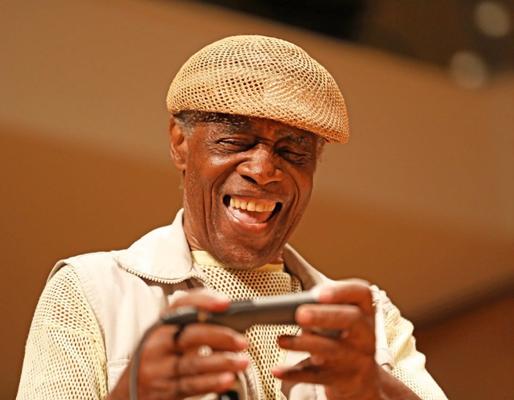
When I interviewed Norman Simmons in 2008 for my book, Jazz Notes: Interviews Across the Generations (Praeger/ABCClio: 2009), he told me about a major turning point in his career.
In 1951, Simmons was playing at Chicago’s Blue Note with a group that included tenor saxophonists Flip Phillips and Bill Harris. “Oscar (Peterson) and Ray Brown were opposite us,” he recalled. “So, I’m coming off the stage, and Oscar grabbed my arm and sat me down at a table beside the stage and said, ‘I see you’re having some problems with your technique.’ He gave me instructions. Plus, I was sitting there all week long watching him. He made me see the difference between what I was doing and what he was doing. He was playing the piano and sweating, and I’m posing. Just watching Oscar and what he showed me
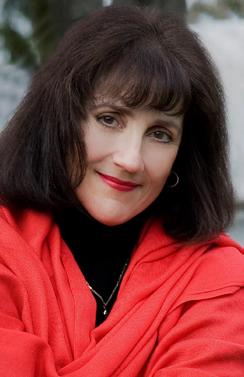


A nice little outdoor dinner show at Lake Lefferts in Matawan with my trio. June 11th, 6:00-8:00, with a rain date of June 12th. 6:00-8:00. Call Angelo’s Pizza, at 732-583-5880.
June 10th, 6:00 at Danny Clinch’s Photo Studio, Asbury Park, sharing the mic from 6:00 on. Fun times…….
NJJS.ORG 38 JUNE • 2021 JERSEY JAZZ BIG BAND IN THE SKY
PHOTO BY CHRISTOPHER DRUKKER.
began to turn my whole world around.”
A resident of Lakewood, NJ, Simmons passed away on May 13, 2021, in Yuma, AZ, at the age of 91. At the time of my conversation with him, over breakfast at the Rainbow Diner in Brick, NJ, he was the pianist in tenor saxophonist Virginia Mayhew’s Duke Ellington Legacy Band, which had just recorded an album, Thank You Uncle Edward on the Remma Recordings label. In addition to Simmons, the album featured baritone saxophonist Joe Temperley, trombonist Wycliffe Gordon, and Ellington’s grandson, Edward Kennedy Ellington II on guitar, among others. Mayhew, on a family visit in California, emailed me the day after Simmons’ death, with this comment: “Norman was such an important part of my musical growth and a longtime friend and musical cohort. Few pianists could fire up a soloist like Norman could.”
Simmons moved from Chicago to New York in the late 1960s and began accompanying vocalist Dakota Staton in 1967. That led to a celebrated career accompanying an array of vocalists that included Ernestine Anderson, Helen Humes, Carrie Jackson, Carmen McRae, Anita O’Day, Carol Sloane, Maxine Sullivan, Melissa Walker, and Joe Williams.
Williams and Simmons were together for about two decades, and Jersey Jazz’s Schaen Fox asked him about that association in the January 2009 issue of the magazine. “Those 20 years with Joe just went by like nothing,” he said, “because he was one of the guys. He was a good vocal musician, relaxed not uptight about anything, and he developed a great respect for me. Everything was marvelous; we had a good time ... Whatever knowledge and information he had he was eager to share it.”
I asked him about Humes, whom
The Mark Clemente Chord MelodiesTM for Guitar
Playable, performance-ready arrangements for solo jazz guitar. Each song is written in notation, tablature, and with chord diagrams. Choose from nearly 50 standards, which are included in two songbooks and available individually.
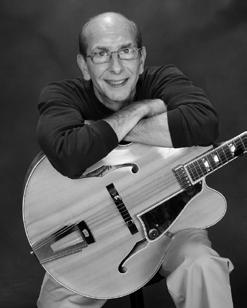
Praise from players at all levels ...
“Lots of guitarists who do weddings would benefit from your arrangements. I’ve learned Fly Me To The Moon , and I’ll be playing it at my next gig. Keep arranging, Mark. We need you.”
—MW, THEWEDDINGMUSICIAN.COM
“Mark, I enjoyed your arrangement of My Romance very much. I teach guitar and am always searching for chord melody pieces that are a bit challenging but ‘doable’ by intermediate players. Keep up the great work!”
—GB, MASSACHUSETTS
“I’m so happy with your arrangements! As a beginner, they are accessible even to me and are excellent studies of chord movement. Can’t thank you enough for these excellent arrangements!”
—DL, KENTUCKY
NJJS.ORG 39 JUNE • 2021 JERSEY JAZZ
BIG BAND IN THE SKY
MarkClementeGuitar.com 201.444.9830
he accompanied at New York’s Cookery. “When I started with Helen,” he said, “I thought I was subbing for her regular piano player. I didn’t realize he had already left (for the West Coast). I didn’t want to do the gig because Barney (Barney Josephson, the Cookery’s owner) would keep people there for months, and I didn’t want to get stuck on a regular gig. But, for some reason, I wound up there anyway. I played with Helen up to the time she died. Everybody loved her. She was such a lovable person. When we went out to eat, I had to learn not to order anything because everybody would just be giving Helen stuff. So, she’d end up with a bunch of samples of food, and I’d have to finish it ... She’s one of a kind.”
During our breakfast, Simmons complained that too many vocalists had become “performers instead of singers. All they want to do is improvise; there’s no singing. It gets
“ I WAS PARTICULARLY INFLUENCED BY DUKE ELLINGTON, AND I STILL AM. ”
away from the interpretation of a song for the sake of the notes.”
In 2010, Simmons presented a Salute to Duke Ellington as part of The Piano in the Parlor series at Centenary College (now Centenary University) in Hackettstown. He led a trio with Tom DiCarlo on bass and Sheila Early on drums. “I was particularly influenced by Duke Ellington,” he told me, “and I still am. When I first heard Duke, I wasn’t even an active musician. I was very much influenced by Jimmy Blanton, the walkin’ bass. Of course, Duke had wonderful soloists like Lawrence Brown and Johnny Hodges, and his music was
songs. So, those two elements—melody and Jimmy Blanton—got to me.”
Simmons was very active as a teaching artist for Jazz House Kids, the Montclair-based jazz education and training program for student musicians. Melissa Walker, JHK Founder and President, recalled to WBGO’s Nate Chinen that, “After I formed the organization in 2012, about two years in, Norman and I used to go into schools in Newark. We had a program called the Vocal Summit, a residency program. And, Norman would write all the charts.”
Another favorite memory of Simmons from his Chicago Blue Note days was his interaction with Billy
Strayhorn. “Duke was going to be coming in the next week,” he said, “and Billy Strayhorn was in town, so they gave Strayhorn the gig to play the week before Duke came in. I was on opposite him with my trio. Strayhorn had been playing ‘A Flower is a Lovesome Thing’, and I asked him for a copy of it. I was playing a song I had recorded with tenor saxophonist Paul Bascomb called ‘Jan’ that had sort of become a hit, and he said, ‘Yeah, I’ll give you a copy. Would you give me a copy of Jan?’ I said, ‘Yeah, I can really hear Johnny Hodges playing that.’ He gave me a copy of ‘Flower’ in his handwriting. I’ve got it at home.”
40 JUNE 2021 JERSEY JAZZ NJJS.ORG
SKY
BIG BAND IN THE
Bob Koester
Bob Knew His Trad and Mainstream Jazz ... But His Ears Were as Open to the Budding New Sounds.
BY DAN MORGENSTERN

When I moved to Chicago, the Jazz Record Mart was one of my first stops. It lived up to its legendary reputation. Bob Koester and his wife, Sue, were kind to the newcomer and introduced me to the South Side blues joints where he was warmly welcomed, and we were the only ofays.
Bob didn’t just record blues people. When Big Joe Williams was down on his luck, he slept in Bob’s store basement. Bob knew his trad and mainstream jazz and pulled my coat to such fine cats as Frank Chace, Nappy Trottier and Wayne Jones, but his ears were as open to the budding new sounds of the AACM (Association for the Advancement of Creative Musicians). He was the first to record its music for his Delmark label. The Mart was a great browse and hang, and Bob was not only a good host but also not one of those dealers who’d squeeze you when
you found a good one—there were vintage 78s as well. All us regulars were sad when the Mart had to move; the new site was roomier and nicely located but that unique ambiance was gone. But Bob was still there … Bob was one of those lucky dads whose sons follow in their footsteps, and the label and store are in good hands. It’s no small feat that Bob managed to stay in business for such a record time, but that’s because it was a labor of love.
Bob Koester died May 12, 2021, in Evanston, IL, at the age of 88. He founded the Chicago-based blues and jazz record label, Delmark, and owned the Jazz Record Mart. His wife, Sue, describing how he loved talking to customers, told The New York Times: “Often they came into the store looking for one thing, and he pointed them in another direction.” His son, Robert, Jr., will continue to manage the store, now known as Bob’s Blues and Jazz Mart.
41 JUNE 2021 JERSEY JAZZ NJJS.ORG
IN THE SKY
BIG BAND
Sax Appeal: Ivy Benson and Her All-Girl Band
By Janet Tennant
ROWMAN & LITTLEFIELD LANHAM 182 PAGES, 2021
BY JOE LANG
Most readers of this review are probably unaware of Ivy Benson, who was an English saxophonist and bandleader from 19391982. Janet Tennant’s Sax Appeal: Ivy Benson and Her All-Girl Band is ostensibly a biography of Benson, but it really is more than that. In telling Benson’s story, Tennant provides much contextual material that places Benson in the center of an overview of the evolution of a woman’s place in the
music business during her lifetime.

Benson, born in November 1913, grew up in trying circumstances in a suburb of Leeds. Her interest in music started at an early age on the piano. Her father, who played trombone in the local symphony, desired his talented daughter to become a classical pianist, but her interest leaned in the direction of jazz. Her instrument of choice was an alto sax, and she learned to play it in two months, also
learning to play the clarinet from her father. She was soon performing in dance bands while also working days in a local factory. This two-sided life became too stressful for her, so she opted to follow her musical muse.
Eventually making her way to London, Benson had a series of jobs before she joined an all-girl band led by Teddy Joyce. The success of this group was short-lived, and, in 1939, Benson decided to form her own band. Her friendship with and support from the bandleader Jack Hylton opened doors for her and, with the demand for entertainment high due to the support it offered the war weary British, Benson landed several choice bookings. Despite many obstacles along the way, she kept busy throughout World War II.
In this period, there was a shortage of musicians due to the number of players who were drafted into the armed services. This provided more
opportunities for women musicians, who were often overlooked because of their gender. Benson was suddenly competing with previously all-male bands for female musicians. Holding onto the female players was also a problem, as many of them got married to servicemen, especially American GIs. So, Benson was continually needing to fill sudden openings in her band. Other problems were shaky finances and the threat of bombings by German military aircraft. It was not unusual for the band to suddenly have to leave the stage and head for air raid shelters.
While many gigs were for civilian audiences, Benson and her band also became a staple of the entertainment for troops at home and abroad. Despite jealousy from her male counterparts, she became a regular performer on the BBC beginning in 1943, the year in which her band made its first recordings
42 JUNE 2021 JERSEY JAZZ NJJS.ORG BOOK REVIEW
and also began a prestigious 22-week residency at the London Palladium.
After the war, she was still playing for the troops. Many of the appearances were in Belgium, Holland, and Germany at British and American bases; and these trips were often expanded to include a variety of other appearances elsewhere in Europe.
On the road, whether in Britain or on the mainland, the musicians were often faced with travel conditions that were trying in terms of weather, accommodations and venues. There was also the continuing issue of personnel turnover.
While she founded her band as a swing band, and continued to play much of that style music throughout her career, Benson possessed the business acumen to understand that, in order to maintain viability as an act in demand, she had to broaden her repertoire to include pop-oriented material.
Ivy Benson’s commitment to her
music was hard to separate from her personal life as she was regularly touring, leaving little time to devote to much of a life outside of music. As a result, most of her friendships were found within her musical circles. Her two marriages did not last, as her lifestyle precluded the kind consistent personal interaction needed for a successful marriage.
When you finish reading this book, you realize that the strength of its content is not related to the life of Ivy Benson. Instead, Tennant has presented an interesting overview of the historical and cultural background in which Benson developed her musical achievements. There is a particular emphasis on the evolution of women’s roles in the British musical scene and also in the broader context of British society. One does not need to have a specific interest in Ivy Benson to become drawn into the overall story that Tennant relates in a highly readable and engaging manner.

NJJS.ORG 43 JUNE 2021 JERSEY JAZZ
BOOK REVIEW
BY JOE LANG
Canadian saxophonist Kevin Goss gives us a taste of his versatility on Gratitude (self-produced), playing baritone, tenor, alto and soprano saxes. The 11-track program finds him in the company of trumpeter/flugelhornist Brian O’Kane, pianist Dave Restivo, guitarist Nathan Hiltz, bassist Jim Vivian and drummer Ted Warren. All except one of the tracks are Goss originals. His predominate instrument is baritone sax, and he gives nods to two of his influences— Pepper Adams on his original, “Cayenne (for Pepper)” as well as Glenn Wilson’s “Adams Park”; and Gerry Mulligan on “Jeruvian (for Gerry).” Goss is a fluid player with nice tone on each of his instruments. Of particular note is his beautiful ballad, “Mists of Fundy,” inspired by the waters of his hometown, Saint John, New Brunswick, that he wonderfully assays on his alto sax. kevin@kevingossjazz.com
Soundtrack (Fresh Sound New Talent – 618) is an interesting collection from alto saxophonist Dmitry Baevsky.
With the backing of pianist Jeb Patton, bassist David Wong, and drummer, Peter Van Nostrand, Baevsky performs a program of 13 selections that trace his journey from his hometown of Saint Petersburg, Russia, to New York City, where he spent several years before settling in his current home base of Paris. In doing so, he mixes original songs with jazz tunes and sprinkles in a few standards. While he plays alto, he has a Getzian quality to his playing. The support from his trio is outstanding. Patton is truly one of the best pianists on the scene today. dmitrybaevsky.com
It is not often that you find a bassoon player on the front line of a jazz ensemble. On The Ox-Mo Incident (Capri – 74165) bassoonist Frank
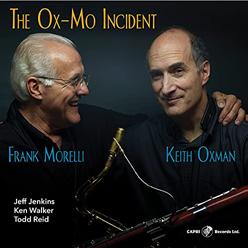
Morelli joins tenor saxophonist Keith Oxman and a rhythm section of pianist Jeff Jenkins, bassist Ken Walker, and drummer Todd Reid for a consistently satisfying set of 11 selections. Several of the selections have their genesis in classical music, “Full Moon and Empty Arms” (Rachmaninoff’s “Piano Concerto No. 2”), “Baubles Bangles and Beads” (Borodin’s “String Quartet No. 2”), “Three for
Five” (Brahms’ “Symphony No. 3”), “Stranger in Paradise” (Borodin’s “Polynesian Dance No. 2”), “Poor Butterfly (inspired by Puccini’s Madame Butterfly ) and “Pavane” (Gabriel Faure). There are three Broadway classics, “Happy Talk” “The Surrey with the Fringe on Top” and “I Could Have Danced All Night,” plus a couple of Oxman originals, “The Ox-Mo Incident” and “A Wrap in Search of a Hart and Lung.” Oxman and Morelli share the spotlight with equal aplomb. They keep things fresh and swinging with fine support from the rhythm section. This is serious and accessible mainstream jazz that consistently delights. caprirecords.com
Pianist Jill McCarron has been a fixture on the New York City scene for several decades, playing at most of the major clubs in town. Jazz Motif (self-produced) is her latest record-
NJJS.ORG 44 JUNE • 2021 JERSEY JAZZ
OTHER VIEWS
OTHER VIEWS
ing, a nicely paced set of jazz tunes with a couple of standards, “All God’s Chillun Got Rhythm” and “My Ideal,” added to the mix. Featured on alto sax and flute is Will Anderson, with bassist Paul Gill and drummer Andy Watson filling out the group. McCarron in an imaginative improvisor with an exquisite touch. Anderson has established himself as a firstrate reedman who always swings and gets a terrific tone on all of the instruments that he takes in hand. Gill and Watson are right there with the time and rhythm. jillmccarron.com
Despite being on the scene for decades, Make Your Move (Cellar Music – 103120) is the first recording as a leader for pianist Ray Gallon. When asked why it took so long to take this step, he responded, “I needed to feel ready – that I had something special to offer.” Well, the results are worth
the wait. He has chosen 11 tunes, nine originals plus “I Don’t Stand a Ghost of a Chance” and “Yesterdays.” Joining him on this musical adventure are bassist David Wong and drummer Kenny Washington, a pair of superior rhythm partners. With mentors such as John Lewis, Jaki Byard and Hank Jones, Gallon is grounded firmly in the mainstream of modern jazz and has developed his own voice. cellarlive.com
Then and Again, Here and Now (Sunnyside – 1608) marks the first recording by pianist Todd Cochran in about 10 years. While he has dabbled in a variety of musical genres in his career, in this album, Cochran concentrates on jazz—the music that expanded his musical horizons beyond his early studies of classical music. His partners in this 15-track undertaking are bassist John Left -
wich and drummer Michael Carvin. Cochran has planned his program carefully, making this studio recording feel like a concert performance with improvised interludes connecting the flow of material. This is listening music best enjoyed fully with no distractions, concentrating on what Cochran is communicating—an hour of exceptional artistry. sunnysiderecords.com
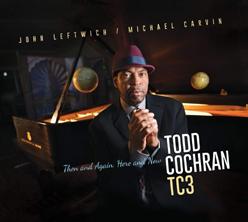
Guitarist Doug MacDonald has been particularly prolific on the recording front in recent times. Live in Hawaii (Dmac Music – 19) contains just short of an hour of music spread over seven tracks. For this session, MacDonald, who lives in Southern California, is joined by three Hawaii-based musicians, vibraphonist Noel Okimoto, bassist Dean Taba, and drummer Darryl Pellegrini. The songs include “My Shining Hour,” “Blues in the Closet,” “Star Eyes,” “Lester Leaps In” and “Stranger in Paradise,” plus two MacDonald originals, “Cat City Samba” and “Bossa Don.” Any group led by MacDonald is guaranteed to be one that never ceases to swing. dougmacdonald.net
I’m Forever Blowing Bubbles (Next Level – 2109) is the first recording as a leader for trombonist/vocalist Hailey Brinnel , and it is an impres -
NJJS.ORG 45 JUNE • 2021 JERSEY JAZZ
OTHER VIEWS
“ YOUNG MUSICIANS SUCH AS HAILEY BRINNEL (ARE) KEEPING THE MUSIC FRESH AND ALIVE. ”
sive debut. Joined by pianist Silas Irvine, bassist Joe Plowman, and drummer Dan Monaghan, with occasional contributions by clarinetist Sam Bishoff, trumpeter Andrew Carson and guitarist Dariel Peniazek, Brinnel addresses eight selections. The program includes seven standards, “Orange Colored Sky,” “I’m Forever Blowing Bubbles,” “Give Me the Simple Life,” “Stardust,” “Easy to Love,” You Go to My Head” and “Show Me the Way to Go Home,” plus a humorous gem written by Busby Martin for the show Five Guys Named Moe , “What’s the Use of Getting Sober.” Brinnel has a smooth voice, fine jazz-influenced phrasing, and an innate sense of swing, attributes that carry over to her trombone artistry. It is encouraging for those who like mainstream jazz that there are young musicians such as Hailey Brinnel keeping the music fresh and alive. haileybrinnel.com
Pianist Terry Waldo , a master of early jazz styles, and vocalist Tatiana
Eva-Marie , best known as the vocalist with the Avalon Jazz Band, have combined for a lively outing on I Double Dare You (Turtle Bay 21-001). This 10-tune collection finds them in the company of Ricky Alexander on clarinet and sax, Mike Davis on cornet, Jim Fryer on trombone, Nick Russo on banjo and guitar, Brian Nalepka on bass, and Jay Lepley on drums. The program is an interesting mix of songs from the ‘20s, ‘30s, and ’40s—“Do Do Do,” “Baby, Won’t You Please Come Home,” “Deep Purple,” “Be Sweet to Me,” “The Very Thought of You,” “I Double Dare You,” “I Must Have That Man,” “Take a Picture of the Moon,” “Runnin’ Wild” and “Two Sleepy People.” Eva-Marie wonderfully captures the sound and style of the period, and Waldo is a powerhouse at the keys, with the band providing the perfect setting for their artistry. turtlebaymusic.com
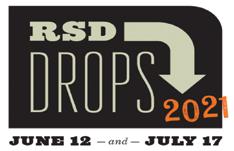
HERE'S SOME OF THE EXCLUSIVE

















NJJS.ORG 46 JUNE • 2021 JERSEY JAZZ
WWW ORIGINALVINYLRECORDS COM ORIGINAL VINYL RECORD YOUR RSD DROPS STORE N E W • U S E D • B U Y • S E L L • T R A D E eigo_ovr_3.25x9ad_newjerseyjazzsociety_june2021_color_Layout 1 5/6/
VINYL COMING OUT FOR RSD DROPS JUNE 12TH
OTHER VIEWS
I’m in Love Again (Turtle Bay – 21002) features vocalist Sweet Meg (Megg Farrell) and reedman Ricky Alexander with support from Mike Davis on trumpet, Rob Edwards on trombone, Dalton Ridenhour on piano, Jerron Paxton on banjo, Rob Adkins on bass, and Kevin Dorn on drums for 11 selections of vintage material. The songs
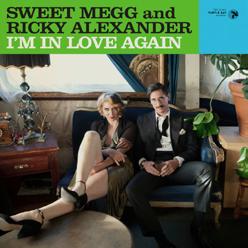
include “My Honey’s Lovin’ Arms,” “Foolin’ Myself,” “Right or Wrong,” “Squeeze Me,” “Last Night on the Back Porch,” “Angry,” “I Got It Bad,” “Ragged but Right,” “I’m in Love Again,” “I’d Love to Take Orders from You” and “A Blues Serenade.” Sweet Megg knows how to put this material across convincingly, and her mates find a similar suitable groove. Turtle Bay is a new record label that describes itself as the home of, “the best younger jazz players playing the best older tunes.” turtlebaymusic.com
The current world of jazz-oriented vocalists is dominated by female singers, but sprinkled in are some gentlemen who deserve attention. Among them is Los Angeles-based Jonathan Karrant who has just released his third album, Shadows
Fall (self-produced), a duo set with pianist Joshua White . He has chosen an interesting mix of songs, mostly standards such as “My Romance,” “Detour Ahead,” “Lush Life”, and “My One and Only Love;” some contemporary songs, “Simply the Best,” “I Try” and “Your Smiling Face;” plus a couple of jazz tunes, Mose Allison’s “Stop This World” and Abbey Lincoln’s “Being Me.” Karrant brings his own vision to each of the selections, with a jazz feeling always present. He has a smooth baritone that lies easy on your ears. White provides solid backing for Karrant, always an important element, but like a good accompanist, in a supporting role. It is good to hear a fresh voice among the male contributors to the vocal jazz scene. jonathankarrant.com
Specializing in Media Campaigns for artists, labels, venues and events

NJJS.ORG 47 JUNE • 2021 JERSEY JAZZ
J i m E i g o J a z z P r o m o S e r v i c e s 2 6 9 S R o u t e 9 4 Wa r w i c k , N Y 1 0 9 9 0 T : 8 4 5 - 9 8 6 - 1 6 7 7 F : 8 4 5 - 9 8 6 - 1 6 9 9 E - M a i l : j a z z p r o m o @ e a r t h l i n k . n e t
r o m o t i o n / M a r k e t i n g D i s t r i b u t i o n / C o n s u l t a t i o n w w w . j a z z p r o m o s e r v i c e s . c o m
P
Jazz Promo Services
1. Nickname for Jackson known for playing 1-Across
2. 2011 NEA Jazz Master recipient Keepnews
3. Instrument for Evans or Brubeck
5. Clarinetist/ saxophonist Cohen
7. Same score, twice, e.g.
Answers on page 49.
48 JUNE 2021 JERSEY JAZZ NJJS.ORG
1 4 5 6 8 7 9 2 3
JAZZWORDS
ACROSS
1. Fast jazz
4. “My Man’s Gone Now”, from “Porgy and Bess”, e.g.
6. Guitarist/ composer Green
8. “Mountain of Moses”
9. Other half of “Blue” jazz spot DOWN
PUZZLE CONSTRUCTED BY LIN JOSEPHSON
THANK YOU and welcome to all who have recently joined or renewed their memberships. We can’t do what we do without you!
Your membership is vital to NJJS’s mission to promote and preserve America’s great art form— JAZZ!
NOT WITHOUT YOU!
RENEWED MEMBERS
Danny Bacher, CLIFFSIDE PARK, NJ
S. David Bailin, MORRISTOWN, NJ
George Bassett, EWING, NJ
Phyllis Blanford-Colleran, NEWARK, NJ
David Braham, UNION, NJ
Lisa Calderwood, HILLSBOROUGH, NJ
Charles Carreras, RINGWOOD, NJ
Beverly De Graaf, MORRISTOWN, NJ
Gerard Deutsch, LIVINGSTON, NJ
Chris DeVito, WARREN, NJ
George Diehl, SHAKER HEIGHTS, OH
Alan Eisenberg, ROCKVILLE, MD
George H. Elwood, UTICA, NY
Kristin Estilow, FREEHOLD, NJ
Gloria & Len Feiner, SPRINGFIELD, NJ
Jane Fuller, PRINCETON, NJ
Herb Gardner, NORWOOD, MA
Neil Gordon, NEW CITY, NY
Mary Hexamer, LAKEWOOD, CO
Brian Hochstadt, MORRISTOWN, NJ
Phil Hunt and Julie Mac, LONG VALLEY, NJ
Thomas Judd, MADISON, NJ
Robert Kurz, LIVINGSTON, NJ
Joe Lang, CHATHAM, NJ
Frank Marrapodi, WATCHUNG, NJ
Joan & Bud Meeker, ROSELAND, NJ
Susie Meissner, LAWRENCEVILLE, NJ
Gene Perla, EASTON, PA
Donald E. Perlman, SUCCASUNNA, NJ
Ken Pokrowski, LINCOLN PARK, NJ
Lynn Redmile, MERCERVILLE, NJ
Robert J. Reid, BOONTON, NJ
Sandy Sasso, OAKHURST, NJ
Danny Scher, KENSINGTON, CA
Nick Scheuble, ROCKAWAY, NJ
Don Jay Smith, LEBANON, NJ
Terrence & Vivian Smith, MORRISTOWN, NJ
Nicholas R. Smolney, OLD BRIDGE, NJ
Ruth Steck, GREEN VILLAGE, NJ
Lee W. Swartz, GULF SHORES, AL
Howard Tavin, FORT LEE, NJ
Wayne & Barbara Thoen, TEANECK, NJ
Tom Toronto, LEONIA, NJ
John Vayda, MAPLEWOOD, NJ
Ira L. Whitman, EAST BRUNSWICK, NJ
Victor Arencibia, MOUNT TABOR, NJ
Peter R. Caldwell, PINE BEACH, NJ
Jan & Bob Findlay, FLANDERS, NJ
Paul Gutheil, GLEN ROCK, NJ
James Kellett, PRINCETON JUNCTION, NJ
James L. McKechnie, NORTH PLAINFIELD, NJ
Scott Olsen, DUNELLEN, NJ
Alan Schneider, MILLBURN, NJ
James Schoen, POTTERSVILLE, NJ
Thomas Shutkin, BUCKINGHAM, PA
Wayne Tamarelli, BASKING RIDGE, NJ
Victoria Width, CALIFON, NJ
NEW MEMBERS
Vincent Cutro, WEST MILFORD, NJ
Rich Engel, MAPLEWOOD, NJ
Marcia Finders
Donald Goldman
Donald Levit, MAPLEWOOD, NJ
Don Morelli
Ben Schwartz
Jason Olaine, MAPLEWOOD, NJ
JAZZWORDS ANSWERS _ Across: 1. Bop 4. Aria 6. Grant 8. Sinai 9. Note Down: 1. Bags 2. Orrin 3. Piano 5. Anat 7. Tie
NJJS org















































































